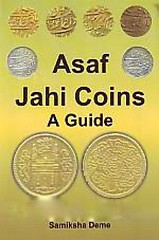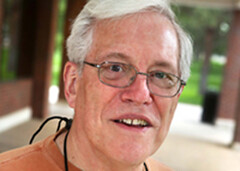
About UsThe Numismatic Bibliomania Society is a non-profit organization promoting numismatic literature. For more information please see our web site at coinbooks.org SubscriptionsThose wishing to become new E-Sylum subscribers (or wishing to Unsubscribe) can go to the following web page link MembershipThere is a membership application available on the web site Membership Application To join, print the application and return it with your check to the address printed on the application. Membership is only $20 to addresses in the U.S., $25 for First Class mail, and $30 elsewhere. For those without web access, write to: David M. Sundman, Treasurer
AsylumFor Asylum mailing address changes and other membership questions, contact David at this email address: dsundman@LittletonCoin.com SubmissionsTo submit items for publication in The E-Sylum, just Reply to this message, or write to the Editor at this address: whomren@gmail.com BUY THE BOOK BEFORE THE COIN |
- WAYNE'S WORDS: THE E-SYLUM SEPTEMBER 7, 2014
- ASYLUM APRIL-JUNE 2014 ISSUE PUBLISHED
- LAKE BOOKS SALE #119 CLOSES SEPTEMBER 9, 2014
- AGORA AUCTIONS OFFER MORE SURBER LIBRARY SELECTIONS
- SKLOW MAIL BID SALE #23 CLOSES OCTOBER 11, 2014
- SAVILLE NUMISMATIC LITERATURE DISCOUNT
- NEW BOOK: THE KENNEDY WORLD IN MEDALLIC ART
- NEW BOOK: COUNTERFEIT PORTRAIT EIGHT-REALES
- NEW BOOK: ASAF JAHI COINS: A GUIDE
- NEW BOOK: COINS OF CHAOS
- ON THE E-SYLUM'S 16TH ANNIVERSARY
- MORE ON DEALER DAVE HESS
- NOTES FROM E-SYLUM READERS: SEPTEMBER 7, 2014
- QUERY: CHINESE RED BOOK KNOCKOFF INFO SOUGHT
- WHY THE CONFEDERATES STOPPED MINTING IN NEW ORLEANS
- CIRCULATING COINAGE IN 1859 ST. LOUIS
- SHERLOCKIAN NUMISMATISTS FORM THE FOURTH GARRIDEB
- MYSTERY NUMISMATIST ANSWER: WALTER BREEN
- SILVER BAR FOR NEW ORLEANS MINT REOPENING
- MECKLENBURG DECLARATION OF INDEPENDENCE CENTENNIAL MEDAL
- QUERY: INSCRIPTION ORIENTATIONS
- MONNAIE DE PARIS COMMEMORATIVE MEDAL CATALOGS
- BALDWIN'S AUCTION 91: THE LINDÉN COLLECTION
- A SOLID GOLD FAKE HOBO NICKEL
- PROTESTER SCRATCHES 'IN GOD WE TRUST' OFF COINS
- THE HERITAGE JAMES SMILLIE ARCHIVE SALE
- THE ROYAL AFRICAN COMPANY MARK
- SOME RECENT COIN DESIGNS: SEPTEMBER 7, 2014
- COIN HONORS BRITISH ARMY'S FIRST BLACK OFFICER
- WWI HORSE HONORED WITH DICKIN MEDAL
- OAK TREE THREEPENCE UNEARTHED IN ENGLAND
- DAVID PICKUP: UNCOMMON THOUGHTS AND RARITIES
- BIN LADEN RAID CHALLENGE COIN
- ASIA’S HIGHEST DENOMINATED BANKNOTES
- BLOGGER REVIEWS MRMOUSE'S COUNTERFEIT CASH
- MAKING THE U.S. $100 BILL
- ROWLAND CONVICT LOVE TOKEN SOLD
- MUSÉE D’ART CLASSIQUE DE MOUGINS
- THE AMAZING NEW IKEA BOOK-BOOK
- FEATURED WEB SITE: INSTITUTE FOR CONSERVATION
Click here to access the complete archive
To comment or submit articles, reply to whomren@gmail.com
WAYNE'S WORDS: THE E-SYLUM SEPTEMBER 7, 2014

New subscribers this week include: Alex Jensen and Bob Gurney. Welcome aboard! We now have 1,762 subscribers.
This week we open with a new Asylum issue, updates on numismatic literature sales from dealers Lake, Agora and Sklow, followed by four new books.
Other topics include dealer David Hess, a Taiwanese counterfeit Red Book, the New Orleans Mint stopping and restarting production, Sherlockian numismatics, medals of the Paris Mint, some auction reviews and previews, and a nearly mint condition Oak Tree coin found in England.
To learn more about godless and dateless coins, Paris the cat, the Dickin medal, the James Smillie archive, counterfeit portrait eight-reales, ‘fine beard’ coins, convict love tokens, a gold Hobo Nickel and the Godfather to All Monkeys, read on. Have a great week, everyone!
Wayne Homren
Editor, The E-Sylum
ASYLUM APRIL-JUNE 2014 ISSUE PUBLISHED
Editor David Yoon writes:
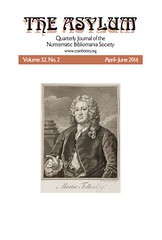 Another issue of The Asylum is
at the printers. Here are the contents:
Another issue of The Asylum is
at the printers. Here are the contents:
George Kolbe - Godfather to All Monkeys: Martin Folkes and His 1756 Library Sale
David Gladfelter - Book Review: U.S. Liberty Head $20 Double Eagles, by Q. David Bowers with Robert Galiette
Despite the short contents list, this is actually a longer issue than usual.
For a membership form, see:
www.coinbooks.org/about/NBS_Membership_Form_2014.pdf
LAKE BOOKS SALE #119 CLOSES SEPTEMBER 9, 2014
This is a reminder that Lake Books’ 119th mail-bid sale of numismatic literature has a closing date of Tuesday, September 9, 2014 at 5:00 PM (EDT). The 488-lot sale features selections from the libraries of Clem Schettino and George Bilodeau and can be viewed at http://www.lakebooks.com/current.html .
Your bids may be placed via email, fax, or telephone until the closing time. Remember that ties are won by the earliest bid received so place your bids early.
Winning bids are shipped via United States Mail using the Media Mail category unless specifically arranged otherwise by our customers. Invoices are mailed after shipment had been made.
Good Luck with your bidding, Fred
Lake Books
PMB 118
6822 22nd Ave. N
St. Petersburg, FL 33710-3918
727-343-8055 FAX: 727-381-6822
AGORA AUCTIONS OFFER MORE SURBER LIBRARY SELECTIONS
Agora Auctions numismatic sale #16 starts to close Tuesday. September 9th, 2014 at 12:00 Noon (EST) with lots closing every 30 seconds. This sale features additional lots from the ancient coin collection and numismatic library of Dave Surber, the founder of WildWinds.com the first and most prominent ancient coin research website.
Also featured are several scarce Roman emperors (Germanicus, Livia, Pertinax, Clodius Albinus), a large selection of scarce Roman Provincial types and another selection of Peter Rosa trial strikes.
Additionally, we are featuring a nice variety of early and modern United States and World banknotes and as always a nice variety of provenanced antiquities
To visit the Agora web site, see: http://agoraauctions.com
To read the earlier E-Sylum article, see:
AGORA
AUCTIONS TO OFFER SURBER NUMISMATIC LIBRARY
(www.coinbooks.org/esylum_v17n32a04.html)
THE BOOK BAZARRE
SKLOW MAIL BID SALE #23 CLOSES OCTOBER 11, 2014
 Greetings fellow Bibliophiles!
Greetings fellow Bibliophiles!
Below are the highlights for MBS # 23 Closing October 11, 2014. It is our largest MBS to date with 1168 lots. All catalogs went in the mail this week and are on their way to you. The catalog is posted on our website.
David
- Scarce 1987 Special Edition RedBook
- Silver Dollars & Trade Dollars of the U.S. by Q. David Bowers, 2 Volume Set
- Continental Paper Money, 1866 by Henry Phillips
- Large offering of works concerning Medals & Tokens
- Original Documents bearing the signature of the Secretary of the Treasury, 1821, 1836, 1849, 1917 and 1953
- Early Coins of America, 1875 by Crosby
- Colonial Currency Reprints 1910-1911 original 4 volumes by Andrew Davis McFarland
- U.S. Copper Cents 1816-1957, Deluxe Full Leather Thick Paper by Newcomb
- U.S. Copper Cents 1816-1957, Deluxe Full Leather Thin Paper by Newcomb
- Complete Set of the Asylum 1980-2012
- Limited Numbered Edition Full Leather RedBook, 2008 Special ANS Edition
- The Shekel, Volumes 1-32 Complete, bound, 1968-1999
- Deluxe Leather Limited Numbered Edition 13 of 25, American Numismatic Biographies by Pete Smith
- Nice Offering of 19th Century Haseltine Auction Catalogs
- Deluxe Bound Numbered 3 volumes of the John Jay Pittman Collection by Akers
- Nice Offering of Works Concerning Counterfeiting
- Extremely RARE 1941 Silver Proof ANA Convention Medal in Presentation Case, to the Director of the Mint, Nellie Tayloe Ross
- Nice Offering of Early & Late ANA Badges & Medals
- Nice Run of Works by Elmore Jones Concerning English Coinage
- An Amazing Offering of the Canadian Antiquarian and Numismatic Journal 1872-1933, by Individual Volumes & Issues
- Description Historique Des Monnaies Frappees Sous L'Empire Romain Communement Appelees Medailles Imperiales, 7 volume set 1859-1868, by Henry Cohen, Ex: William Sumner Appleton Library
- Financing An Empire: History of Banking in California, Deluxe Edition, 1927, 4 volume set by Ira B. Cross
- Fabulous Signed Letter from Farran Zerbe on Lewis & Clarke Centennial Exposition Letterhead
- RARE 1912 ANA Membership Card, issued to Canadian Member Andrew Browning Baird
- Rarities of Numismata Typographica: Four Examples of Early Dutch Printers' Bookbinders' & Booksellers' Guild Medals: Cast in Sterling Silver, 1996, Bird & Bull Press Numbered Limited Edition 28 of 120, Book and Medals in Slipcase
- Scarce ANA Executive Director's Survival Medal
- 1925 Original Early Quarter Dollars of the U.S. by A.W. Browning
- Numisma - New Netherlands Coin Co. 1954-1960 Complete
- Complete Set of the Asylum 1980-2013
- History of The Bureau of Engraving and Printing, 1964, The BEP's Own Copy No. 2
- Long Run of Barney Bluestone Auction Catalogs
- Very Long Run of M.H. Bolender Auction Catalogs
- Plated Henry Chapman Catalog of the Matthew Stickney Sale
- Plated Henry Chapman Catalog of the C.A. Baldwin Sale
- Extremely Rare Plated S.H. Chapman Catalog of the Charles Gordon Zug Sale
- Plated S.H. Chapman Catalog of the Major Richard Lambert Sale
- Plated S.H. Chapman Catalog of the Julius L. Brown Sale
- Plated S.H. Chapman Catalog of the Sterling P. Grove Sale
- Long Run of Henry Chapman Auction Sales, Many Scarce Small Size in Cloth
- Long Run of S.H. Chapman Auction Sales
- Nice Offering of Early Redbooks and Bluebooks by Yeoman
- RARE ANA Membership Directories
- RARE Early Issues of The Numismatist 1892 & 1893
- Long Run of the Numismatist 1894-1919 Offered by Individual Volumes
- Long Run of the Numismatist 1920-2013 as one lot
- Scarce Hardbound Editions of Heritage Auction Catalogs
- Scarce Hardbound Editions of Steve Ivy Auction Catalogs
- Nice Offering of Deluxe Stacks Auction Catalogs
- Run of Deluxe Ford Sale Catalogs
- Nice Offering of Deluxe Superior Auction Catalogs
- A Complete Run of Morgenthau Auction Catalogs
- Nice Run of Wayte Raymond Auction Catalogs
- Much, Much More!!!!!!!
David Sklow-Fine Numismatic Books
P.O. Box 6321
Colorado Springs, CO 80934 vPH: 719-302-5686
FAX: 719-302-4933
Email: numismaticbooks@aol.com
Web Site: FineNumismaticBooks.com
SAVILLE NUMISMATIC LITERATURE DISCOUNT

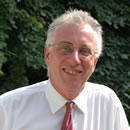 In response to my request for
information about Dave Hess in last week’s issue, I received a
few emails from various readers of The E-Sylum. One
correspondent mentioned the fact that Dave Hess “sold out to
Spinks in 1969” – a fact apparently stated in his final pricelist
issued in that year, and a fact that was unknown to me.
In response to my request for
information about Dave Hess in last week’s issue, I received a
few emails from various readers of The E-Sylum. One
correspondent mentioned the fact that Dave Hess “sold out to
Spinks in 1969” – a fact apparently stated in his final pricelist
issued in that year, and a fact that was unknown to me.
Well, that reminded me that I started working at Spinks in early September of 1969- so this month marks my 45th year connected with numismatic literature.
Howard Linecar, who had by that time been at the old company since the mid-1930s, was then Manager of the Book Department. Howard had worked with Leonard Forrer in the Coin Department for 15 years or so, and had been “promoted” to become Manager of the Book Department, a post that had been more or less created for Howard since he had proved himself to be a better numismatic editor and writer than a coin-dealer.
I learned much of what I know about the numismatic book-publishing business (as it existed at that time) from Howard - and Spink were of course the largest and most important publisher of numismatic books during those years. Spink & Son Ltd. were also one of the leading coin and medal dealers not only in London, but also in Europe. Working in the Coin Department were Douglas Liddell, Patrick Finn, Andre de Clermont, Mark Rasmussen and George Muller, amongst many others; Edward Joslin headed the Medal Department.
However, that is by the by, and for anyone interested, more details about my first 34 years at Spink can be found in The Asylum, Volume XXII, No. 3. Summer 2004. (pp. 307-337): Recollections of 34 Years at Spink, 1969-2003.
I left Spink in 2006, and started my business the following year. On my website I have listed for sale some 800 books. To mark my 45 years of dealing in numismatic books, anyone who orders anything from my website (assuming it hasn’t been sold already!) by 12 September will receive a 25% discount on the price asked – it is best to email any orders to me: info@douglassaville.com
To visit Douglas' web site, see:
www.douglassaville.com
To read the earlier E-Sylum article, see:
NOTES
FROM E-SYLUM READERS: AUGUST 31, 2014 : Query: Information on
Dave Hess Sought
(www.coinbooks.org/esylum_v17n36a07.html)
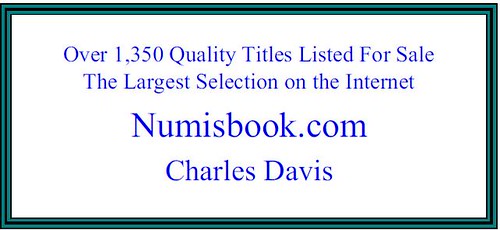
NEW BOOK: THE KENNEDY WORLD IN MEDALLIC ART
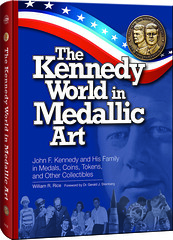 Whitman Publishing
announces the release of The Kennedy World in Medallic Art:
John F. Kennedy and His Family in Medals, Coins, Tokens, and
Other Collectibles, by William R. Rice. The 304-page
hardcover book will be available September 25, 2014, from
booksellers and hobby shops nationwide and online (including at
www.Whitman.com), for $19.95. It can also be borrowed for free as
a benefit of membership in the American Numismatic Association,
through the Dwight N. Manley Numismatic Library
(www.money.org).
Whitman Publishing
announces the release of The Kennedy World in Medallic Art:
John F. Kennedy and His Family in Medals, Coins, Tokens, and
Other Collectibles, by William R. Rice. The 304-page
hardcover book will be available September 25, 2014, from
booksellers and hobby shops nationwide and online (including at
www.Whitman.com), for $19.95. It can also be borrowed for free as
a benefit of membership in the American Numismatic Association,
through the Dwight N. Manley Numismatic Library
(www.money.org).
In this monumental new book, Kennedy historian Rice offers fresh insight on the life and times of the president. His exploration includes the history of the Kennedy family; JFK’s boyhood; his military service and early political career; his inauguration and presidency; Jacqueline and the children; life in the White House; the November 1963 assassination; and the world’s mourning and remembrance.
The story is told through touching and insightful essays illustrated by more than 1,500 images including coins, medals, tokens, stamps, and other memorabilia. Many are popular and collectible, like the 1964 silver Kennedy half dollar (with its mintage of 429 million coins) and the new 2014 gold Kennedy halves. Others are rare and seldom seen, and some one-of-a-kind.
“William Rice builds on the foundation that Edward Rochette and Aubrey Mayhew started with their numismatic studies in the 1960s,” says Whitman publisher Dennis Tucker. “Today’s collector benefits from full-color images and 50 years of ongoing research. John F. Kennedy is one of the most popular presidents in American history, and many of these coins, medals, and tokens can be found at local coin shows, flea markets, antique malls, and online.”
Special sections discuss subjects like satirical and critical pieces; brothers Robert F. and Teddy Kennedy; the Peace Corps; and paper money issued during the Kennedy administration.
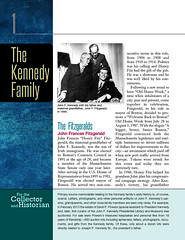
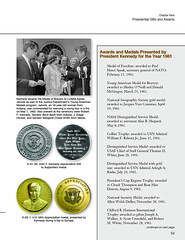
Military challenge coins are given extra attention (with more than 180 images) as are foreign and domestic “march” medals, commemorative postage covers, world coins, and medal sets. Rice discusses and illustrates Chinese Hell notes, carved hobo coins, Wedgwood pottery, silver bullion bars, elongated coins, and many of other categories of Kennedy collectibles.
In addition to colorful historical images and narrative, the book’s scholarly appeal is expanded by multiple appendices, a bibliography, and a full index. Collectors will benefit from the catalog numbering system and commentary on today’s buy-sell-trade market. A 52-page appendix catalogs more than 2,670 individual items by date, size, composition, and description.
“Historians will remain deeply indebted to William Rice for his gigantic addition to the field of John F. Kennedy medallic art and related historical memorabilia,” says noted Kennedy historian Dr. Gerald J. Steinberg.
The Kennedy World in Medallic Art: John F. Kennedy and His
Family in Medals, Coins, Tokens, and Other Collectibles
By William R. Rice; foreword by Dr. Gerald J. Steinberg
ISBN 0794842364
Hardcover, 8.5 x 11 inches • 304 pages • Full color
Retail $19.95 U.S.
For more information, or to order, see:
The Kennedy World in Medallic Art
(www.whitman.com/store/Inventory/Detail/The-Kennedy-World-in-Medallic-Art+0794842364)
NEW BOOK: COUNTERFEIT PORTRAIT EIGHT-REALES
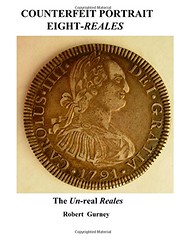 Counterfeit Portrait
Eight-Reales: The Un-real Reales (Counterfeit Eight-Reales)
(Volume 1)
Counterfeit Portrait
Eight-Reales: The Un-real Reales (Counterfeit Eight-Reales)
(Volume 1)
Paperback – September 2, 2014
by Robert Gurney (Author)
Gordon Nichols (Contributor)
John Lorenzo (Contributor)
The portrait style Spanish-American eight-reales was one of the most well-known, and extensively circulated silver trade coins that the world has ever seen. Produced in Spain's new world colonies from 1772 to 1825, the coin made Spain a major player on the world financial stage in the eighteenth and early nineteenth centuries. This was due in large measure to the fact this coin accounted for about sixty percent of the annual silver production worldwide.
The popularity and general acceptance of this particular coin – the portrait style piece-of-eight – made it the object of forgers who operated in all areas of the globe. It was a coin not merely counterfeited in the countries of origin, but in all of the places where it was accepted as currency in day-to-day transactions. It was produced in small back-room operations and in large factories. It was produced at times in utter secrecy, yet at other times it was more or less an “open secret.” It was produced as both worthless base metal copies and as “perfect” imitations containing the correct amount of silver. It has been made to circulate as currency, as well as to specifically deceive collectors.
The fascinating story of these counterfeit issues created from shortly after the coin appeared until the present, is the subject of this book. The author, Robert Gurney, known to many coin collectors as “Swamper Bob,” has been a lifelong enthusiast of the series. His interest commenced as a teen when he met and spoke to one of the forgers who actually made these coins for a living in the 1920's. The story may at times not seem possible, but the newest scientific tests available provide conclusive evidence for the production of counterfeit versions made for circulation as late as 1930.
With contributions made by several notable collectors, including Richard August, John Lorenzo and Gordon Nichols, this book documents the four different classifications of counterfeit eight-reales developed by the author to fit the needs of this particular series. The book illustrates and describes literally hundreds of different types of counterfeits known to have circulated alongside the genuine versions. It specifically expands upon the Thirty-nine varieties noted by Dr. John L. Riddell as existing in circulation in New Orleans in 1845, and swells that number to some 589 varieties.
This book was not written just for coin collectors, the subject is actually much broader. It is at its heart a history of the coin covering a period of 240 years of use and production. It is also the story of the methods and reasons for producing both counterfeits and forgeries during that same interval. The players and their motivations for the production of deceptive copies for over 240 years, provides insight into human nature.
The book is presented as a start to a long needed discussion - one that is decades overdue. It is only a start. The author hopes that this publication will bring old counterfeits out of their hiding places and into the light of day, where the varieties from childishly crude to artistically superb can be appreciated by everyone.
Solamente el comienzo!
Product Details
Series: Counterfeit Eight-Reales
Paperback: 600 pages
Publisher: CreateSpace Independent Publishing Platform;
First edition (September 2, 2014)
Language: English
ISBN-10: 1500497177
ISBN-13: 978-1500497170
Product Dimensions: 11 x 8.5 x 1.4 inches
Shipping Weight: 3.7 pounds
About the author
Robert Richard Gurney is a native son of Massachusetts and a Twelfth generation Yankee, now retired and living in the land of Andy Griffith. Educated as a Civil Engineer, he holds a B.S in Civil Engineering, S.C.L. from the University of Massachusetts, Dartmouth. He is married to his first true love, Elizabeth (Bixler) Gurney and together they have three children. A nearly lifelong coin collector and avid student of history, Gurney has spent decades collecting and analyzing counterfeit coins that circulated as currency in the United States before 1857.
Since meeting a self-confessed forger, who claimed to have produced counterfeit silver Mexican eight-reales in the 1920s, Gurney has been fascinated by these “foreign” coins that represented about 90% of the circulating silver specie in the United States before the Civil War. Always a supporter of the UNDERDOG (think the Red Sox in 1967), Gurney hopes to place the eight-reales counterfeit coins on an even footing with other series of counterfeit coins seen as being collectable. He views the Contemporary Counterfeit Portrait Eight-Reales as a long neglected underdog in the world of numismatics.
Regarding my second volume - I plan to produce a volume devoted to the Cap and Ray counterfeits. My emphasis there will be on the varieties similar to the coins listed in Riddell's "Monograph of the Silver Dollar, Good and Bad" from 1845 and I plan to extend those listings to coins dated as late as the end of the first republic ca 1862.
If time (my time on earth) allows I then plan to expand the coverage of the Cap and Ray counterfeits into the period of the second Republic and through 1897.
I actually started with the Portrait coin book project because that opportunity was presented to me first. The project, as I currently understand the process, was initially developed by the former curator of the ANS (Mr. Hoge) in conjunction with Mike Ringo, John Lorenzo and Gordon Nichols. The primary author was to be Mike Ringo. After Mike's death, I was asked to get involved.
It began as a collaborative effort at first, but in the long run I became primary author by agreement of the others. John Lorenzo was to write the coin descriptions and he also wrote the sections on metal analysis and XRF testing. Gordon Nichols did the initial die classifications for 120 coins using the ANS preferred system which treated obverse and reverse dies independently. This method has been shown to work with Half Pennies and Two reales and it was assumed that it would be good for the Portrait 8Rs as well.
As time passed and the book grew, I felt we had to scrap the system in favor of a model (similar to Davignon) that linked the two dies into mated pairs of date AND mint taken together. This was necessary because the vast majority of contemporary counterfeit portrait coins carry the Mexico City mint mark and because sharing of dies was clearly not as commonplace among the dollar sized coins as it was for half pennies or Two reales. Where most half pennies share dies in nearly 50% of cases and two reales share dies in over one third of cases - the 8Rs share dies in only 5% of cases. I chose to use mated pairs because it represented 95% of all cases.
One of the critical elements of the book which led to the American Numismatic Society backing out of publishing the book (with my wholehearted agreement) was that I wanted to include the topic of the silver counterfeits made from 1830-1930 for the China trade. ANS saw the "story" as unbelievable even though I have historic documentary evidence and scientific testing to support my theories. Of course I also had a chuckle for myself because the person doing the review for ANS believed that the coin I used on both front and rear covers of the book was REAL. It is actually a Sheffield plate counterfeit confirmed by both XRF tests and Specific Gravity. It has under 60% of the appropriate silver content and has a clear ribbon seam in the dentils. Yet the reviewer said we were wrong to identify the coin as a counterfeit since it was most likely genuine.
There were a few other critical issues where I could not see eye to eye with ANS either. I wanted to list coin-like-objects such as buttons, religious, political medals, hobo-carvings, replicas and other uses (using one or two examples of each type) just to spur interest in those collectables. ANS wanted to reduce the section to one page. I wanted to define terms and create a glossary for things like "colonial" to distinguish between US colonial (ends 1776 to 1781) and Spanish colonial (ends 1820 - 1830). ANS wanted to use existing terms as they are currently used because that was adequate and my definitions were confusing.
I chose to list four types of fraudulent or unlawful coins - Contemporary Circulating (base metal) - Contemporary Circulating (silver) - Numismatic Forgeries (made for collectors) and Frauds (mined or doctored coins etc.). However ANS saw no value in that and preferred only two classes contemporary and modern counterfeits.
I chose to include complete typescripts of Riddell (1845) and Bordeaux (1905) because the texts of both works needs to be readily at hand for understanding the book. ANS wanted those eliminated because they could be found elsewhere. I wanted to use descriptions of the coins that relied on the use of pictures backed up by available Disc copies of all the coins but ANS wanted detailed written descriptions of each coin so they could be identified without pictures.
The ANS rejection was for me a blessing. It allowed me to go further afield and to include necessary discussion points - things beginning collectors need to know and understand. ANS and I wanted to produce different books for different audiences. The split was absolutely necessary.
Anyway that is why and how things reached this point.
I have always wanted to do a book on the early Cap and Ray Counterfeit coins because I started collecting them first when I was a pre-teen. I did not even own a counterfeit Portrait 8R until 1960. I also have a much larger collection of Cap and Ray 8R counterfeits (3,600) compared to just about 600 Portrait 8R coins so I have much more to work with as far as raw material goes. I also view the counterfeiting of the Cap and Ray coins as far more straight forward an activity than the Portraits because the C&R 8Rs did not have the market driver caused by the premium paid by the Chinese for Charles IV 8Rs from Mexico City.
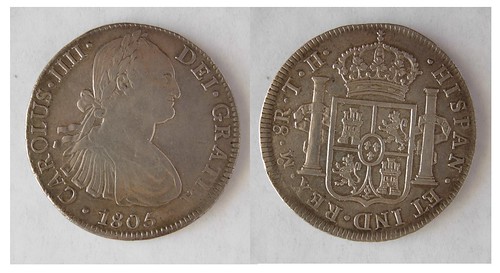
Here's a picture of the first counterfeit Portrait counterfeit that I got from a self-confessed counterfeiter in 1960-2 who said he made it in Massachusetts the 1920s. The coin has been proven to have too little gold as a contaminant (to have been made in 1805) by two different XRF laboratories and this coin is the basis for my belief that full weight silver counterfeits were produced for the China trade as late as 1930.
A recent test run at RTI International has returned a preliminary signature match with an example of the 1896-O micro O Morgan dollar. I am resubmitting both coins to RTI next week for XRF re-testing with a brand new state of the art XRF testing machine which will do far finer analysis of the trace contamination (down to 1 ppm for 72 elements) in the hopes of proving that the source of both coins is identical.
For more information, or to order, see:
Counterfeit Portrait Eight-Reales: The Un-real Reales
(Counterfeit Eight-Reales) (Volume 1)
(www.amazon.com/Counterfeit-Portrait-Eight-Reales-Un-real-Reales/dp/1500497177/)
NEW BOOK: ASAF JAHI COINS: A GUIDE
Authors (s): Deme Raja Reddy (Author) , Samiksha Deme (Author)
Format: Hardcover
ISBN-13: 9789350501757
Pages: vi+74p., Illustrations; Chiefly Colour; Maps; 23cm.
Pub. date: 25.07.2014, 1st. ed.
Publisher: B.R. Publishing Corporation
Language (s): English
Bagchee ID: BB87985
List price: US $ 47,00
Bagchee price: US $ 42,30
Contents:
1 Introduction
2 Asaf Jahi Dynasty
3 Asaf Jahi Coinage
a Coins of Mir Qanaruddin-Asaf Jah I (1137-1162
AH/1724-1748 AD)
b Coins of Nasir Jung (1161-1164 Ah/Ah/1751-1752
AD) and Salabat Jung (1164-1175 Ah/1752-1762 AD)
c Coins of Nizam Ali Khan-Asaf Jah II (1175-1218
AH/1761-1803 AD) Chalni Coins
d The Coins of Sikandar Jah-Asaf Jah III (1218-1244
AH/1803-1829 AD)
e Coins of Nasir-ud-Daula-Asaf Jah IV (1244-1273
AH/1829-1857 AD)
f The Coins of Afzal-ud-Daula-Asaf Jah V (1273-1285
AH/1857-1869 AD)
g The Coins of Mir Mahboob Ali Khan-Asaf Jah VI
(1285-1329 Ah/1869-1911 AD)
h The Coins of Mir Osman Ali Khan-Asaf Jah VII
(1329-1367 AH/1911-1948 AD) 'The Nazarana Coins'
4 Mints and Marks of Asaf Jahi Coins
5 X-Ray Diffraction and X-Ray Fluorescence Study of Asaf Jahi
Silver Coins
6 Distinguishing Features of Asaf Jahi Coins
7 Epilogue
For more information, or to order, see:
Asaf
Jahi Coins: A Guide
(www.bagchee.com/books/BB87985/asaf-jahi-coins-a-guide)
To read the earlier E-Sylum article, see:
BETTER
PRICES FOR NUMISMATIC BOOKS FROM INDIA
(www.coinbooks.org/esylum_v17n24a05.html)
NEW BOOK: COINS OF CHAOS
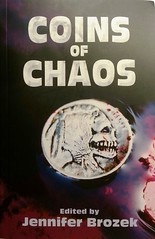 A short story book with skull hobo
nickels was also published in 2013. An article about a skull hobo
nickel found in change may have even been the creative stimulus
for the book. The “Coins of Chaos” book has doom and gloom
stories about skull hobo nickels that find their way into the
hands of the unsuspecting. Each nickel was cursed by an evil
magician who maintains everlasting youth through the demise of
others unlucky enough to cross paths with his nickel
creations.
A short story book with skull hobo
nickels was also published in 2013. An article about a skull hobo
nickel found in change may have even been the creative stimulus
for the book. The “Coins of Chaos” book has doom and gloom
stories about skull hobo nickels that find their way into the
hands of the unsuspecting. Each nickel was cursed by an evil
magician who maintains everlasting youth through the demise of
others unlucky enough to cross paths with his nickel
creations.
The book is a collaboration by different authors with each one telling their own short story. It appears that these hobo nickels continue to make headway into popular culture. This Halloween maybe hobo nickel collectors should think about preparing an exhibit on skull carvings for a local library or even contacting a local newspaper to run a human interest story on them.
For more information about the Original Hobo Nickel Society,
see:
www.hobonickels.org
ON THE E-SYLUM'S 16TH ANNIVERSARY
From Uruguay Horacio Morero writes:
FELICITACIONES EDITOR DE E-SYLUM !
Felicitaciones en mi nombre y en nombre de todos los que
conformamos el Instituto Uruguayo de Numismática.
From New Zealand Jim Duncan writes:
Hard to believe how giant oaks from little acorns grow, but this is living testimony.
From Canada Paul Petch writes:
It was nice to see your top story last week on the anniversary of what has come to be known as The E-Sylum. I did not realize until reading it that in being one of the originals the attached message went out to only 49 people.
Back in 1998 my e-mail address was petch@humberc.on.ca. I spearheaded the project that got Humber College, here in Toronto, on the Internet for September 1990, the start of our school year, so had lots of time to distribute that address. Perhaps I had included it when I renewed my NBS membership.
I have made a practice of archiving e-mails right from those earliest days. As the e-mail computer platform has changed I carefully port all the files forward. I remember being very excited to receive the Sept 4, 1998 message and opened a new folder right away. In scanning that folder, I guess I have all the E-Sylums ever sent. It reveals how much of a personal project it has been for you right from the start. It even originated from your personal e-mail account until December 23, 2001 when the coinlibrary.com domain started to be used.
Thank you for the constant and steady work you have put into the venture over the years. It is an indispensable part of every bibliophile's source of news and a research library in its own right.
When I built the NBS web site I did it on down time at my job to teach myself HTML. It came in handy when the company tapped me to run their first web-building project. The email address I used then was a company one, homren@cgi.com.
The coinlibrary.com address is actually a personal one. I set it up at telerama.com, one of the first ISPs in the world, and I got an account early on to use at home. Today I use gmail over a Verizon FiOS connection. I suppose now I could move to a tablet and work from my couch, but a laptop is still easier for content creation.
Editing The E-Sylum is definitely a chore, but a fun one because of the interesting, constantly-changing content and the great people that are part of our community. -Editor
To read the earlier E-Sylum article, see:
E-SYLUM
ANNIVERSARY: SEPTEMBER 4, 2014
(www.coinbooks.org/esylum_v17n36a02.html)
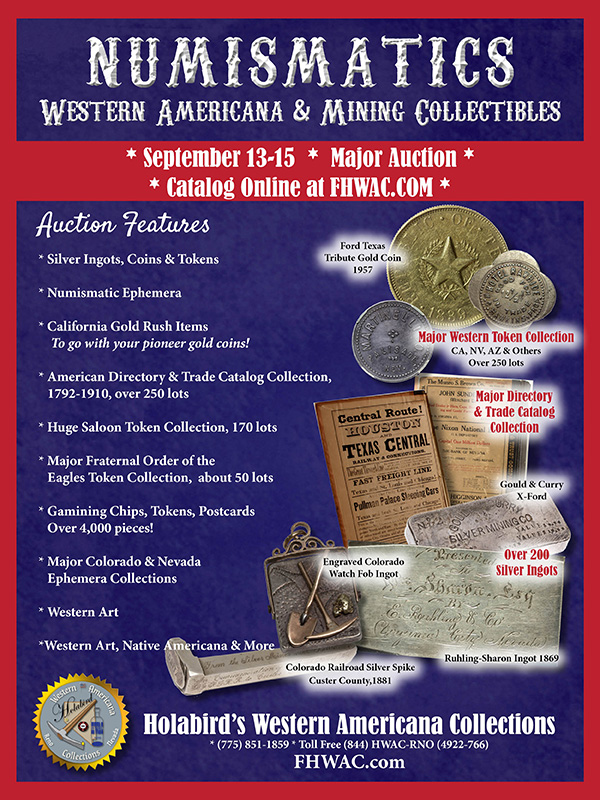
MORE ON DEALER DAVE HESS
Regarding Doug Saville's inquiry about dealer Dave Hess, Paul Bosco writes:
Dave Hess was a specialist in British coins, mainly early. I believe he was known mainly thru his FPLs. I expect there are issues in the ANS library. I never knew him, but someone once told me I reminded him of Hess, a comment intended as high praise. It occurs to me that the more committed Anglophiles of the US coin trade may be less well known in the USA than generalists. Maybe it's the narrow focus, maybe they're too courtly.
Allan Davisson writes:
I have a few his coin lists that I have kept since I was a college student in the late 1960s and was just in the process of discovering British coins. He dealt in British coins on a part-time basis but his lists were extensive, nicely detailed and a pleasure to read. I talked with him a time or two on the telephone and he was friendly and helpful and very knowledgeable about the series.
He lived in the south—Louisiana? But he did not have a southern accent. As then 70s progressed I lost touch with him. I seem to recall his announcing his retirement from coins about that time. From time to time I would run across coins with his name on the envelope and I valued the pedigree.
Andy Singer writes:
I knew Dave Hess most of the time he was in business, and stayed in contact for a few years after; however, around forty years have gone by since then. The last thing I heard was perhaps ten or more years ago, and that was that he was still working for the State of Louisiana. There is still a David Hess in Baton Rouge, at the same Post Office, too, but with a different box number. But allow me to backtrack a bit:
Dave Hess played a major role in getting American collectors interested in collecting British coins, especially hammered issues before 1662. Dave Bowers preceded Dave Hess by highlighting Victorian copper coins on his lists in the 1950s, Dave Hess helped make hammered coins a popular collecting specialty in the 1960s. He began his mail order business in 1962 or 1963.
My first list was #1-64 from January, 1964 and these continued until the business was closed in September and October 1968. His lists were very popular and sold out quickly. The lists from 1966 and 1967 were reprinted and perfect bound and available to anyone who wanted to buy a bound copy. Dave sold his library to Spink and Son at the close of his business. He was a fulltime CPA, and chose to concentrate on that profession. His remaining stock was sold at auction, but I never found out who auctioned the coins.
This probably doesn’t help Doug too much, but it also adds to my curiosity as well. I have some other interesting Dave Hess stories, but that’s for a later time.
To read the earlier E-Sylum article, see:
NOTES
FROM E-SYLUM READERS: AUGUST 31, 2014 : Query: Information on
Dave Hess Sought
(www.coinbooks.org/esylum_v17n36a07.html)
NOTES FROM E-SYLUM READERS: SEPTEMBER 7, 2014
More on 'No God But Allah'
Paul Schultz writes:
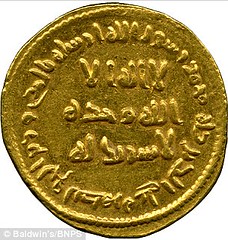 I thought I would add a bit on the
phrase "No God But Allah" on coins. The reason
the gold coin that you mentioned was so important is that this is
the Kalima (or sometimes the first of the 6 Kalimas), used first
on Umaiyid coins and continuing for centuries. The Kalima reads
La ilah illa Allah wahdahu la sherik lahu, or There is
No God Except Allah, He Is Alone, There Is No Partner To Him.
It is in the center of one side of typical Umaiyid coins.
I thought I would add a bit on the
phrase "No God But Allah" on coins. The reason
the gold coin that you mentioned was so important is that this is
the Kalima (or sometimes the first of the 6 Kalimas), used first
on Umaiyid coins and continuing for centuries. The Kalima reads
La ilah illa Allah wahdahu la sherik lahu, or There is
No God Except Allah, He Is Alone, There Is No Partner To Him.
It is in the center of one side of typical Umaiyid coins.
These standard sayings on Arabic coins are covered nicely in Richard Plant's "Arabic Coins and How To Read Them". Others with more knowledge than I have may have better information, but it seems that this expression is of widespread importance on many Arabic coins for centuries, comparable to the In God We Trust on US coins.
To read the earlier E-Sylum article, see:
'NO
GOD BUT ALLAH' OVERSTAMP REAPPEARS
(www.coinbooks.org/esylum_v17n36a11.html)
How Many 1974 Aluminum Cents?
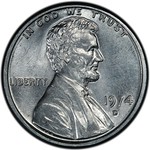 Last week we excerpted a
newspaper story about the disputed 1974-D aluminum cent, which
included this passage:
Last week we excerpted a
newspaper story about the disputed 1974-D aluminum cent, which
included this passage:
Hundreds of thousands of 1974 aluminum pennies were made and handed out to U.S. dignitaries
Tom DeLorey writes:
For want of a comma, the meaning was lost.
Thank you for the update on the 1974-D aluminum cent, though I am amazed to learn from the article quoted that hundreds of thousands of them were both made AND handed out to U.S. dignitaries. Here I had thought that only a few dozen of them were handed out in the Hauls (sic) of Congress.
To read the earlier E-Sylum article, see:
FIGHT
CONTINUES OVER 1974-D ALUMINUM CENT
(www.coinbooks.org/esylum_v17n36a27.html)
Typo Time: August 34, 1863
Chip Howell noticed a typo in last week's quoted article on
the Chaffee Confederate note and letter, which referred to a note
dated "August 34, 1863". He writes:
Hmmm--I didn't realized calendars had changed THAT much!
To read the earlier E-Sylum article, see:
CONFEDERATE
QUARTERMASTER'S AGENT ORESTES PARMENO CHAFFEE
(www.coinbooks.org/esylum_v17n36a17.html)
The Colonial Coin Cake

Ben wrote:
Last night my incredible wife surprised me by inviting essentially all of my closest friends and family to a surprise birthday party for me here on the Jersey shore. People flew out from all over to be here and I was utterly shocked. Apparently, the theme was my love for colonial coins. Check out the unbelievable cake she got me... She told me it is supposed to be a "simian arm"!
Paris the Numismatic Literature Watch Cat
Numismatic literature dealer David Sklow writes:
I thought readers might enjoy this photo of my guard cat. His name is Paris and he watches over the current auction lots.
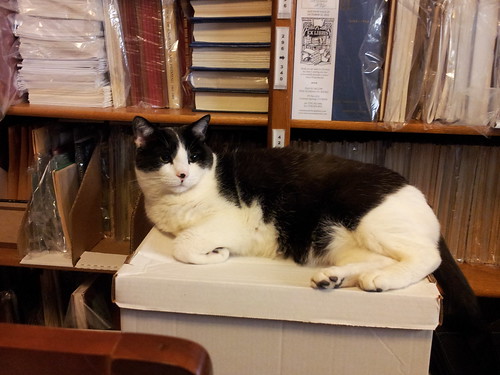
Washington Quarter Sand Sculpture
Steve Shupe writes:
Attached please find a picture taken at the Santa Cruz Beach Boardwalk in California the Tuesday following the Labor day weekend. Could this be a new mint process in finalizing a coin Pattern? Or maybe the return of the spider-hair Washington quarter? Maybe a comment on the eroding value of our pocket change? Just like our pocket change, here today, gone tomorrow. At least our books have a more lasting value.
There is a sand sculptor who does a new sand sculpture once or twice a week on the beach. His artwork varies from fanciful mermaids, whales and even worker cherubs with coins. Here’s hope that everyone had a relaxing holiday!
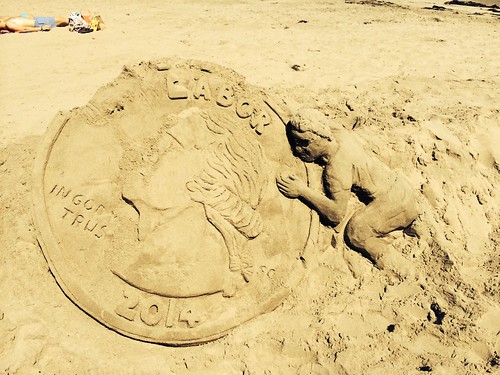
QUERY: CHINESE RED BOOK KNOCKOFF INFO SOUGHT
Tom writes:
I apparently have had this for quite some awhile. I don't recall how or just when I got it. I just noticed though that it is the only copy with a dust jacket. The cover color is different as is the print on the spine.
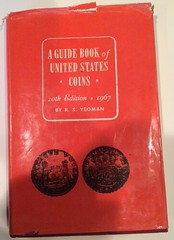
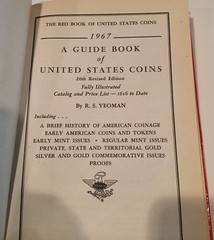

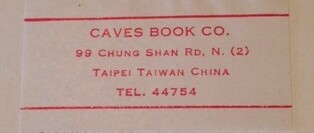
Dennis writes:
That's quite the numismatic oddity! Ken Bressett and I have had many interesting conversations about the highways and byways traveled by the Red Book over the years. I remember him telling me about Chinese counterfeits --- essentially pirated publications of the book, printed clandestinely and completely unauthorized by Whitman Publishing. I believe this is an example of just such a counterfeit.
A natural question might be, "Why on Earth would anyone print a fake Red Book?" Consider this: The 1965 (18th) edition, published in 1964, sold 1.2 million copies --- ranking it fifth on the list of best-selling nonfiction (ahead of Dale Carnegie's "How to Win Friends and Influence People" [no. 6] and John F. Kennedy's "Profiles in Courage" [no. 9]). Apparently someone with more understanding of printing presses and not so much of American copyright law got their hands on printing plates or otherwise arranged to pirate this tempting treasure.
This was probably made in 1966 (which was the publication year of the authentic 1967 edition) or perhaps in 1967. How many were made, and how were they distributed? I don't know. . . . but it suggests some intriguing scenarios, doesn't it?
WHY THE CONFEDERATES STOPPED MINTING IN NEW ORLEANS
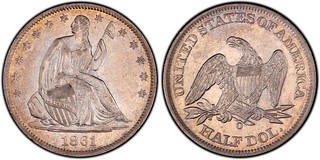 I especially enjoyed the article;
“HOWARD BERLIN VISITS THE NEW ORLEANS MINT”. I must, however,
respectfully disagree with one statement, specifically - “…the
Mint struck coins for the Confederacy for less than one month, as
it quickly ran out of bullion.”
I especially enjoyed the article;
“HOWARD BERLIN VISITS THE NEW ORLEANS MINT”. I must, however,
respectfully disagree with one statement, specifically - “…the
Mint struck coins for the Confederacy for less than one month, as
it quickly ran out of bullion.”
Under both Louisiana and Confederate authority (and using US dies on hand), the Mint did indeed strike half dollar coins for the Confederacy. They also struck four Confederate Half Dollars with a new Confederate reverse die. My quibble is with the “…quickly ran out of bullion” comment. This popular misconception has unfortunately been perpetuated for so many years that it has come to be accepted as fact.
The actual explanation for the discontinuation has two reasons. The first was an April 12th, 1861 letter in which Treasury Secretary Memminger instructed New Orleans Mint Superintendent William Elmore to cease operations, writing - “...it is not probable that much coinage will be required, while it is certain that the Government will need the Bullion Fund for its necessities.” He also directed Elmore to - “..dismiss workman so as to leave the establishment merely property taken care of..”.
The second reason was discontinuation of the new Confederate Half Dollar. The new reverse die for it had been prepared by New Orleans die sinker August H. M. Peterson (aka Patterson), but neither Peterson nor the Mint’s Chief Coiner Dr. B.F. Taylor had experience sinking coinage dies. As a result the depth of the engraving on the new die made it impossible to mount and strike coins with it in the Mint’s steam press. The two dies were thus placed in an old screw press and the four half dollars were struck by hand. This would obviously be a most inefficient coining procedure and was thus the end of the new Confederate half dollar coin. The four coins were given to officials and were not seen again until they started reappearing in 1879.
Finally, lest there still be any doubt about “…quickly ran out of bullion”, we have the records of the Confederate assay office in Dahlonega, Georgia. After the Dahlonega Mint ceased coining operations in the Fall of 1861, Memminger, in response to Georgia gold mining interests, ordered the Mint to remain open as an assay office and bullion repository. In July of 1862 Assayer Lewis W. Quillian received the largest shipment the Dahlonega office would ever get - the bullion from the New Orleans Mint that had been sent out of the city ahead of invading Union forces. When assayed it amounted to some 17 gold bars and 196 silver bars!
To read the earlier E-Sylum article, see:
HOWARD
BERLIN VISITS THE NEW ORLEANS MINT
(www.coinbooks.org/esylum_v17n35a27.html)
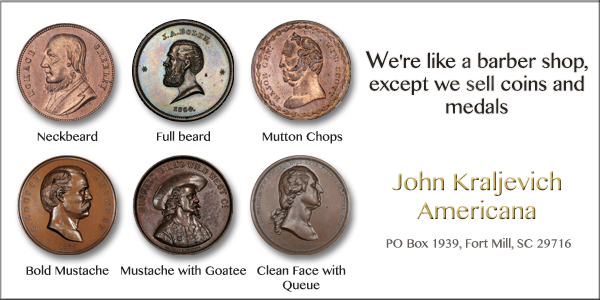
CIRCULATING COINAGE IN 1859 ST. LOUIS
St. Louis as seen by a traveling Californian in 1859
by Jim Laughlin, LSCC #876
The following is a firsthand account of what was seen in circulation in St. Louis, Missouri during 1859 (population 135,330). It is written by a Californian for an audience back home in California.
May 16, 1859, Sacramento Daily Union
Bits have entirely disappeared from circulation, and the dime and half-dime have taken their place. In fractions the decimal system prevails. Nothing is sold for thirty-seven and a half cents—that figure is equivalent to 40 cents. So the seller gains by the change. Foreign “quarters” are also nearly forced out of circulation, although with pillars upon them clearly defined they pass in trade for their nominal value.
Bank notes pass from hand to hand rather more recklessly than you might suppose, considering the number of counterfeits afloat. Extremely careful men always have the “Detector” at their elbows, but the great mass of tradesmen rely on instinct to scent a counterfeit. From superficial observation one would not suppose there is a scarcity of money just now in this region, nor do I hear of distress of any kind….
The panic of 1837 and the subsequent bankruptcy of the States of Mississippi, Louisiana, Florida, Arkansas, Michigan, Indiana, Illinois, Maryland, and Pennsylvania (all by 1841), influenced the delegates framing the California Constitution in 1850. Many eastern residents were financially ruined by holding paper money issued by States, transportation companies, and private banks that had become worthless following the panic. Therefore, the California delegates included a provision in the California Constitution prohibiting the issuance of paper money in California. This explains the interest the reporter has with people using paper money so freely in St. Louis.
The Act of Feb 10, 1857 called in foreign silver to be replaced with the new small sized cents on the East Coast. Here in St. Louis, it appears that the old large cents were scarce and were referred to as being only seen in the “dusty boxes at the Post Office.” (Coin was generally held in wooden trays (boxes) placed near the tellers; at closing, the trays were removed to be secured in a locked safe.) This being apparently a swipe by the author that cents once spent at the Post Office, stayed there. The layer of dust showed that the tellers never touched the cents stored in the boxes. Our reporter reveals that (large) cents are held in contempt back in California.
By 1859, the dime and the half-dime had replaced the Spanish “Real” (“bit” or 12 ½ cents) or the ”Half-Real” (medio or 6 ¼ cents). The author’s reference to foreign “quarters” (i.e. 2 Real pieces) nearly being forced out of circulation, except for those with the “pillars” clearly being “defined,” is interesting. (Silver coins of the Spanish Empire through 1821 were struck with a reverse device of a globe supported on either sides by pillars (i.e. the Pillars of Hercules)).
As strongly “defined” pillars would tend to indicate light circulation wear, these coins were likely closer to full silver weight and therefore continued to pass at 25 cents (2 bits), although it may have been at the 20 cent official U.S. Government rate. It is interesting that despite all the New Orleans mint Liberty Seated quarter dollars produced since 1840, St. Louis still used pre-1822 Spanish Empire coins. Also, Mexican Republic “cap and rays” 2 Real coins (post-1823) apparently didn’t make it North to St. Louis.
Merchants in California and the new Territory of Nevada during 1859 were still pricing tolls, drinks, and items for sale using the Spanish “bits” (12 ½ cents), despite the San Francisco Branch Mint producing Liberty Seated dimes starting in 1856. The reference by the reporter that in St. Louis nothing was being sold for 37 ½ cents (3 bits), that merchants were pricing such “37 ½ cent” items at “40 cents” and in effect keeping the change, was (in my opinion) the reporter just “making hay” for the audience back home. I’m not quite sure whether this was because “bits” were still in circulation in California or whether it was just fair game to attack a merchant that appeared too greedy.
This period, however, is about the start of the constant bickering that shows up in the California Press regarding merchants retaining the “bit” pricing, even though “bits” were no longer in circulation in California. The smallest coin in circulation became the dime, and, therefore, anything priced at a “bit” (12 ½ cent) meant someone would take a loss on the transaction, and more often than not, it was not the merchant. Even the striking of half-dimes starting in 1863 at San Francisco never seemed to change the debate.
Over the years I've also come to cherish first-hand accounts of coin circulation. There's no substitute in numismatic research for these primary source materials. Kudos to Jim Laughlin for finding this article, and for so ably interpreting it for today's audience. -Editor
For more information on the Liberty Seated Collectors Club,
see:
www.lsccweb.org
SHERLOCKIAN NUMISMATISTS FORM THE FOURTH GARRIDEB
Welcome to The Fourth Garrideb, a scion where we celebrate Canonical and Conanical numismatics. There are many specialized Sherlockian scions devoted to very narrow fields – The Elusive Bicyclists, Moriarty’s Mathematicians, and The Practical, But Limited, Geologists, just to name a few. Why shouldn’t there be a scion devoted to Sherlockians who are also coin collectors.
Back in the early and mid 1990’s, Ed Rochette and I had a few conversations, while we were attending annual conventions of the American Numismatic Association (ANA), about forming a Sherlockian coin club. Unfortunately, we were never able to follow up on this.
Fast forward to January 2014. Yours truly was laid up with a severely broken right ankle for several months and started rereading the Canon. Also during this time, season 3 of BBC’s Sherlock premiered on my local PBS station. I started recalling my conversations with Ed and decided to see if it would be feasible to try to form a club of coin collecting Sherlockians.
I reached out to a few other collectors via email and the response was positive. A few weeks later, The E-Sylum published a query of mine on this topic and several other coin collectors responded with interest. It was decided that we would meet in Chicago during the American Numismatic Association’s World’s Fair of Money in August.
Seven brave and hearty souls arrived for our organizational meeting on Saturday, August 9, 2014. These seven Founding Charter members will be known as Syracusan Members – of the finest period.
There was a general discussion about whether a club like ours would be of interest to others and it was decided that it was. Conversation followed regarding coins being mentioned in the various Holmes stories and I shared some literature from my library relating to Holmes and Numismatics.
Bob Fritsch suggested we call ourselves The Fourth Garrideb, after The Adventures of the Three Garridebs, and recounted how Ed Rochette referred to himself as Nathan Garrideb. It was unanimously decided to use this as our name.
Another discussion centered around the need to catalog Holmes related numismatic items and it was agreed that this would be one of our scion’s major goals. It was also discussed that we would produce an electronic journal, with the possibility of an annual hard copy of the previous year’s posts.
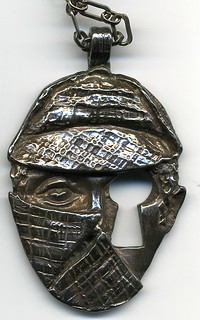
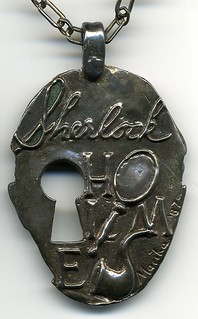
To read the complete article, see:
How The Fourth Garrideb Came To Be
(fourthgarrideb.com/2014/09/how-the-fourth-garrideb-came-to-be/)
MYSTERY NUMISMATIST ANSWER: WALTER BREEN
Dave Alexander writes:
Any chance our mystery numismatist with the wavy hair is the late Howard R. Macintosh of Tatham Coin Co., Springfield, MA? He was a kind of pioneer in mass marketing of inexpensive coin sets, singles, even the few medal series that were then beginning to appear. MacIntosh committed suicide of Sept. 5, 1958.
Larry Dziubek writes:
Could this mister-E numismatist be David Schenkman? I think I can see a banjo image outlined in those curly locks.
Dave Lange writes:
The mystery photo is an easy one. His face aged over the years and was buried in whiskers, but his eyes remained the same---Walter Breen. I believe that is his Harvard yearbook photo.
Others supplying the correct answer included Dave Bowers, Gene Anderson, Ken Berger, and Pete Mosiondz, Jr.

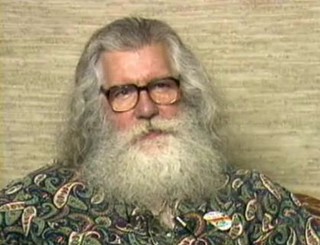
Walter Breen in college circa 1952 and 1986.
Pete Smith writes:
I suggested that Wayne run the Breen picture again to introduce a research tool. If you are using Google Chrome as your browser, and right click on the image, you get an option "Search Google for this image." Selecting that option will bring up several examples of the Breen picture with more information.
This may have been available for years but I just discovered it recently. I used it to identify the sculptor of the Fields medal a couple of weeks back. When I find a coin illustration that has been taken from an auction listing without attribution, I can trace that image back to the auction.
Google also offers pictures it considers similar to the one selected. I found some of these amusing. Google thought Breen looked like Michael Jackson, Elizabeth Taylor and Mr. Bean among many others.
To read the earlier E-Sylum articles, see:
NOTES
FROM E-SYLUM READERS: AUGUST 31, 2014 : Quick Quiz: Who is This
Mystery Numismatist?
(www.coinbooks.org/esylum_v17n36a07.html)
WALTER
BREEN AT JOHNS HOPKINS
(www.coinbooks.org/esylum_v12n47a13.html)
THE BOOK BAZARRE
SILVER BAR FOR NEW ORLEANS MINT REOPENING
 While studying my
1892 U.S. Assay Office New York ingot at the ANA in Chicago with
Fred H, he mentioned that he had handled a silver ingot from the
U.S. Mint New Orleans that dated back to 1879. Fred had worked to
ultimately place the ingot in the U.S. Mint New Orleans Museum
which is now the Louisiana State Museum. Fred's familiarity
with the U.S. Mint New Orleans ingot, and its placement, were
what led to our determination that the 1892 U.S. Assay Office New
York ingot equals the oldest silver government ingot known in
private hands.
While studying my
1892 U.S. Assay Office New York ingot at the ANA in Chicago with
Fred H, he mentioned that he had handled a silver ingot from the
U.S. Mint New Orleans that dated back to 1879. Fred had worked to
ultimately place the ingot in the U.S. Mint New Orleans Museum
which is now the Louisiana State Museum. Fred's familiarity
with the U.S. Mint New Orleans ingot, and its placement, were
what led to our determination that the 1892 U.S. Assay Office New
York ingot equals the oldest silver government ingot known in
private hands.
The U.S. Mint New Orleans was built in 1835 and conducted United States coinage operations from 1837 until 1861 when Louisiana seceded from the Union.The Mint remained closed throughout the Civil War and Reconstruction period, reopening and once again producing United States coinage in 1879.
According to the Louisiana State Museum, (with the help of Fred's original research) this ingot is "one of a kind and was most likely created as a presentation piece for the reopening of the New Orleans Mint after the Civil War in 1879".
I appreciate the assistance of Polly R-S, Curator of the Louisiana State Museum, in providing me with the photo that follows along with information on this amazing historical ingot.
To read the complete article, see:
U.S. Mint New Orleans
(silveringot.blogspot.com/2014/09/us-mint-new-orleans.html)
MECKLENBURG DECLARATION OF INDEPENDENCE CENTENNIAL MEDAL
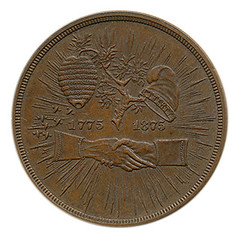
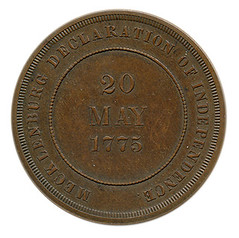
In brief, some historians believe that representatives of Mecklenburg County met on May 19th and 20th in 1775 to discuss, debate and decide what steps would be taken by the county in response to the increasing oppression they were being subject to by King George III, the British Parliament and local Crown authorities. Further, it is said that the assembled representatives developed a series of resolutions that declared Mecklenburg County’s independence from Great Britain; the document is said to have been read to an assembled public on May 20, 1775 from the steps of the Charlotte Courthouse. If this is all true, it would be very significant considering it occurred more than a year before the national Declaration of Independence was approved by the Continental Congress in Philadelphia on July 4, 1776.
There is a problem, however. No original written copy of the May 20th resolves exists and no contemporary newspaper accounts of the meetings or the alleged public reading of the document have been found. “Proof” of the document comes from the memories and testimonies of those claiming either to have signed the original document, been part of the meetings that created them or at least present in Charlotte at the time of the meetings. This makes some believe that the events and document are more fantasy than reality – but no one knows for sure!
As the 1875 Mecklenburg Declaration centennial approached, plans were put in place for Charlotte to host a grand celebration of North Carolina’s role in helping propel the original 13 American colonies toward independence from Great Britain. The celebration would take place over two days – May 19th and 20th – exactly 100 years after the purported meetings that led to Mecklenburg County dissolving its ties to the British Crown.
As part of the centennial’s commemoration, it was decided by its organizing committee to have a medal struck. In early 1875, William Johnston, a successful North Carolina lawyer and businessman who was then also the Mayor of Charlotte, approached Richard Henry Linderman, Director of the US Mint, concerning the striking of a commemorative medal to help mark the centennial.
A private citizen or group contacting the Director of the Mint directly to get a medal authorized would not be possible today – the US Congress needs to be involved – but it was not uncommon in the mid-1800s. The engravers and production facilities of the Mint were often engaged to design and strike medals for a variety of private/personal purposes. Many of these personal requests were made directly to the Director or through one of the Mint’s engravers.
The medal’s obverse features several symbolic design elements. At its center is a tree branch supporting a Phrygian (Liberty) cap and a hornet’s nest (complete with flying hornets). The hornet’s nest is a reference dating to the Revolutionary War. After British General Lord Cornwallis unsuccessfully battled local militias in the Battle of Charlotte in September, 1780, he wrote that Charlotte was “a hornet’s nest of rebellion.” “Hornet’s Nest” was soon adopted as the city’s moniker and later became part of its official seal. Also seen on the obverse are the anniversary dates “1775 – 1875” and a pair of clasped hands (with some of the longest fingers you’ll ever see!) representing the post Civil War reconciliation of the North and South. The central design elements are surrounded by a series of rays.
The simple reverse features the inscriptions MECKLENBURG DECLARATION OF INDEPENDENCE and 20 MAY 20 1775.
The US Mint struck 1,005 silver medals and 1,000 bronze medals on standard coining presses; 25 bronze and five silver proofs were also struck. Both medals are difficult to find today and, as would be expected, nice examples command quite a premium.
To read the complete article, see:
The Mecklenburg Declaration of Independence Centennial Medal
(www.coinweek.com/featured-news/mecklenburg-declaration-of-independence-centennial-medal/)
QUERY: INSCRIPTION ORIENTATIONS
Bruce Smith writes:
I have a question for E-Sylum's resident wordmasters. When a coin or medal has an inscription running in the border or near the edge of the flan, the bottoms of all the letters may point inward, OR they may point outward, OR the top inscription may have the letters pointing inward and the bottom inscription will have the letters pointing outward. Is there a term for these different orientations?

Smith Type 1: all inscriptions point inward
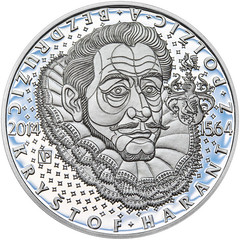
Smith Type 2: all inscriptions point outward
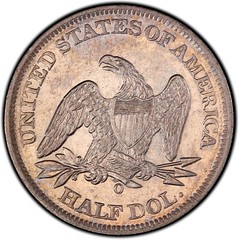
Smith Type 3: top inscription inward, bottom inscription outward
MONNAIE DE PARIS COMMEMORATIVE MEDAL CATALOGS
David Gladfelter writes:
Regarding Tom Garver’s inquiry about Monnaie de Paris catalogues, there are probably a number of them. The one I have is titled "Catalogue Général des Médaille".
Paul Bosco writes:
The Catalog General de la Monnaie (=Mint) de Paris is a series of paperbound books, about 8 1/2 x 11". I have them and I think they were done in the 1960s-70s. Vols. 1 & 2 are early issues; essentially these are catalogs of what the Mint restruck. The very important Volume 3 covers the great art medals periods, 1871-1945. Most of these medals, though produced at the Mint, have not been available for decades. Volume 4 was published in multiple parts --I have three-- and it is like Volume 3, but covers the less popular modern artists, and the late work of some "Volume 3 artists." I paid something like $125 for my set in the 1980s (to Dick Johnson?) Good luck if you want the books now. Also, like Krause-Misher catalogs, they become frayed. They are rather like the Kenneth Failor catalog of US Mint medals, If there was no Juilian and if the US Mint made five times as many medals.
Scott Miller writes:
The Paris Mint has been issuing catalogues for 200 years or more. I have several issued over the years, the earliest being from 1817. In addition to a number of specialized exhibition catalogues issued post World War II, including the ever popular La Medaille en France de Poscarme a la fin de la Belle Epoque from 1967, there is a multi-volume catalogue of medals that can be thought of as seven phone books. The Catalogue General Illustre des Editions de la Monnaie de Paris is a five volume work in seven parts, though I have heard there may be another additional volume. The seven are
1. De L’Antiquite a Louis XVI
2. De la 1ere a la 3e Republique
3. La Troisieme Republique
4* De 1945 a nos jours (A-D)
4** De 1945 a nos jours (E-O)
4*** De 1945 a nos jours (P-Z)
5. Index thématique
Please forgive me for not including the appropriate accent marks. The post-1945 volumes list medals published through the late 1970’s.
David T. Alexander writes:
I suspect that Tom Garver may be thinking of the Catalogue Generale Illustre des Editions de la Monnaie de Paris, a six-volume paperback set, each book measuring 20.2 x 29.5 cm (11-5/16 x 8-3/16 inches). These books list, describe and illustrate by black and white halftones nearly all medals struck by the Paris Mint since the reign of King Louis XI, ca. 1468. Added are listings of medallic copies of ancient coins, seals, coin weights and every imaginable kind of quasi-medallic item offered by this historic Mint, whose collection of working dies includes some 125,000 die pairs.
Volume 1 covers Antiquity through the Constitutional reign of King Louis XVI; vol. 2 chronicles the Revolution through Napoleon, the restored Bourbons, Louis Philippe, Second Republic and Napoleon III. Volume 3 covers the Third Republic from 1870 until 1940. All medals introduced since 1945 are divided alphabetically by artist, and covered in three even thicker volumes described as Volume 4*, 4** and 4***. I obtained my set some 30 years ago, and am not certain whether they are still offered by the Mint.
The amount of information contained is staggering. Artists, sculptors, historical figures of every kind are included. To use these books required understanding of the ground rules. The Paris Mint routinely strikes all of these medals today, regarding all types as open-ended and intended for re-issue. The term Restrike is never used. Consider the Comitia Americana series commissioned by America’s Continental Congress during our Revolution. All are available today. For more than a century the Libertas Americana medal was not offered but examples from copy dies can now be obtained.
Modern strikes are identifiable by their very newness and by their patina. Most medals bear Edgemarks including Privy Marks that first appeared in the 1830s and provide approximate dating for strikes made before the 1970s. These marks state the actual metal, such as OR (Gold), ARGENT (Silver), CUIVRE (Copper) or BRONZE. Today an actual date of striking appears on the edge in incuse numbers.
Hope this info is of use. If desired I could submit a list of the relevant Edgemarks. Try cataloguing a Napoleonic collection without knowledge of these marks!
Dick Johnson writes:
If Tom Garver is inquiring about the Paris Mint Catalog I can add some details. While collectors call it the "Paris Mint Catalog" its official title is Catalogue General Illustre des Editiones de la Monnaie de Paris.
It is five volumes bound in seven (volume 4 covering the 20th century requires three volumes). The entire volume 5 is an index. It is self contained in heavy paper covers. All total there are 3,539 pages!
First three volumes are by periods of French history. Volume 1 covers medals up to the 18th century. Volume 2 is the First and Second Republics. Volume 3 is the Third Republic. And that volume 4 (in three) is the 20th century. The work of 815 artists are listed in volume 4.
Every medal is illustrated. This is not a catalog of all the medals struck by the Paris Mint. It is a catalog of all the medals the Paris Mint has for sale! The Paris Mint, it appears, has never discarded a die. It has kept dies since the 15th century. These are still serviceable (although some of the early dies can only strike soft tin to prohibit breakage).There is a name for these tin restrikes but the name eludes me for the moment.
I don't have a count for the total number of medals covered in the catalog. I estimate it is between 15 and 18 thousand. If they don't have any particular medal in stock when you order, they will retrieve the dies and restrike. This has given rise to the collector term "Paris Mint restrike."
Whether you like or dislike restrikes is a matter of opinion. It is, perhaps, a typical French cosmopolitan concept of long-standing heritage. It is a way the French honor their history with numismatic issues, making these medals available for all time. I personally don't find these restrikes offensive. They are not surreptitious copies -- they are official issues from a national Mint of great reputation.
When obtaining a Paris Mint medal on the secondary market it is not impossible to learn when it was struck by the use of the Paris Mint's mintmarks (subject of another article). It may not be as exact as a collector may desire as the cornucopia mintmark was is use from 1880 until late in the 20th century. Recently, however, the Paris Mint has been adding the year restruck on the edge.
This massive, magnificent catalog is a tribute to one man, Pierre DeHay, a one-time Director of the Paris Mint. The seven volumes were published 1977 to 1981 during DeHay's administration. He was undoubtedly the instigator and overseer of this work. One wonders, however, how many French writers, photographers and editors -- government workers -- he had to hire to create this comprehensive illustrative publication.
The catalog is so important I have two sets in my library. I have dog-eared some 20th century pages. I have record of 228 medals the Paris Mint made of American interest. Remember, it struck America's first national medals, including the Libertas Americana Medal -- and thanks to Benjamin Franklin -- the American Committa Series (which the Philadelphia Mint later restruck American versions). It has also honored American historical events, as well as French, such as Lindbergh's flight and America's space flights.
As long as I am interested in medals I never want to be without a copy of the Paris Mint Catalog!
Tom Garver adds:
I knew that these had been issued, and have seen reference to them, but wondered if an enduring reference such as this might have been issued on CD as have the volumes of Forrer's catalogue.
To read the earlier E-Sylum article, see:
NOTES
FROM E-SYLUM READERS: AUGUST 31, 2014 : Query: Monnaie de Paris
Commemorative Medal Catalog
(www.coinbooks.org/esylum_v17n36a07.html)
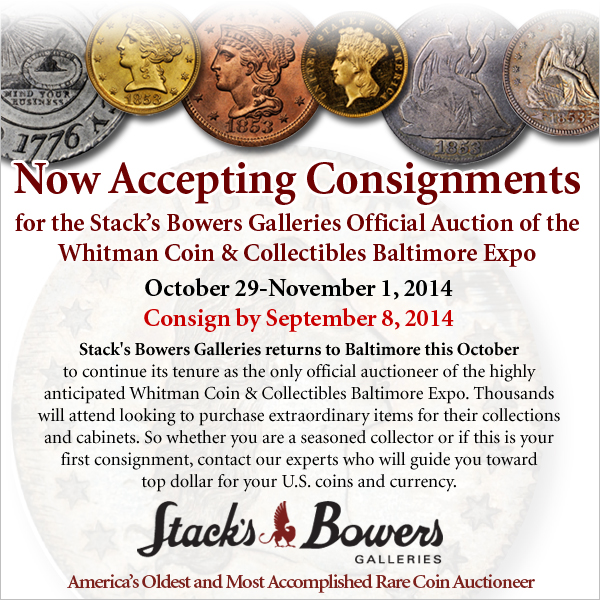
BALDWIN'S AUCTION 91: THE LINDÉN COLLECTION
A.H. Baldwin & Sons Ltd, the official sponsors of Coinex 2014, are delighted to be offering the final part of the exquisite Åke Lindén Collection in Baldwin’s Auction 91; World Coins from The Lindén Collection and Other Properties. This staggering collection has dominated both Baldwin’s auction calendar and the wider numismatic market during 2014.
With a combined sale total of over $7.5 million to date, the finale sale of Lindén’s coins is sure to see his collection consolidate its place as one of the greatest 19th and early 20th century coin collections in recent years. A spectacular auction for quality and rarity, the sale offers collectors coins from across the globe and history. The auction will be held on 25th September 2014 at The CIPFA conference centre in London, as the official auction of Coinex, the International Coin Fair set in London.
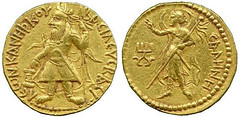 Of particular interest from the
coins of India is an Ancient Indian Kushan Empire, Kanishka I (c.
127-152 AD) Gold Dinar. Struck on the obverse is Kanishka, whilst
the reverse of the coin depicts the Greek moon-goddess
Selene.
Of particular interest from the
coins of India is an Ancient Indian Kushan Empire, Kanishka I (c.
127-152 AD) Gold Dinar. Struck on the obverse is Kanishka, whilst
the reverse of the coin depicts the Greek moon-goddess
Selene.
The Selene type is without question the rarest of only four Greek deity types in the gold coinage of Kanishka. It represents Hellenistic influence and is testament to the variety of religious beliefs tolerated across the Kushan Empire during Kanishka’s reign. It is believed that Kanishka himself practised both Buddhism and the Zoroastrian cult of Mithra.
This coin presents an extremely desirable companion piece to the Kanishka Helios type, her brother the sun. Extremely fine and of the highest rarity, this coin is believed to be the only example in private hands and is estimated at £25,000-35,000 (US$40,000-60,000) [Lot 3830].
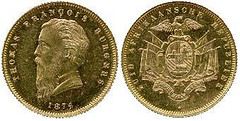 The sale also boasts the first gold coin from the Republic of
South Africa, the 1874 Gold Pond. The South African Republic
(Zuid Afrikaansche Republiek) had been petitioning for an
indigenous coinage since 1853. It was not until 1874 that
President Thomas François Burgers (1872-1877) approached the
Heaton Mint in Birmingham to begin production.
The sale also boasts the first gold coin from the Republic of
South Africa, the 1874 Gold Pond. The South African Republic
(Zuid Afrikaansche Republiek) had been petitioning for an
indigenous coinage since 1853. It was not until 1874 that
President Thomas François Burgers (1872-1877) approached the
Heaton Mint in Birmingham to begin production.
The mint proposed two designs, 695 ‘fine beard’ coins and 142 ‘coarse beard’ pieces. The Legislators objected to Burgers use of his own profile on the coins and rejected both designs. As a result, Burgers Ponds were sold as mementoes, with many being altered and set into jewellery.
The successful revival of the Pond in 1892 and the conclusion of the Boer War, ignited numismatic interest in the Burgers Pond, but only a tiny number of these coins remain in mint state. This particular example, with the rarer ‘coarse beard’ design remains in choice mint state with full original lustre and an attractive light tone. One of the finest known examples of this very rare variety, it is estimated to achieve £40,000-60,000 (US$65,000-100,000) [Lot 3395].
 Also leading the Africa and
Indian Ocean section, from Zanzibar, is a Sultan Barghash ibn
Sa’id, Gold 2½-Riyals, 1299 AH (1881-1882). The Krause ‘Standard
Catalogue of World Coins’ notes that only 2 or 3 of this coin are
known to exist. This example is estimated at £40,000-60,000
(US$65,000-100,000) [Lot 3444].
Also leading the Africa and
Indian Ocean section, from Zanzibar, is a Sultan Barghash ibn
Sa’id, Gold 2½-Riyals, 1299 AH (1881-1882). The Krause ‘Standard
Catalogue of World Coins’ notes that only 2 or 3 of this coin are
known to exist. This example is estimated at £40,000-60,000
(US$65,000-100,000) [Lot 3444].
To visit the Baldwin's web site, see:
www.baldwin.co.uk
A SOLID GOLD FAKE HOBO NICKEL
“Daddy” Comes Home
By Ralph Winter, HLM37
In the spring 2011 issue of BoTales (Vol. 20, Issue 1), I shared that in December of 2010 I had bid on and won an unusual lot in a mail bid sale. The catalog had a so-so photo of the item described as, “Unusual original carved likeness of a shortened profile man in a round top derby with bow & band, modified ear, hair and features as well as collar and lapel. All fields nicely smoothed and entire coin has been gilt or gold plated.”
When I received the coin, I immediately determined that it was not a hobo nickel but was a cast fake of a hobo nickel. I initially was a little upset that I had paid so much for a “gold plated” cast fake. I was ready to return it to the auction house and get my money back.
I showed this golden fake to friend and OHNS member Art DelFavero. He immediately noticed how heavy it was, most unusual for fakes of this kind. I was really surprised when I had it weighed and the gold tested. My cast fake weighed 7.1 grams and was solid 22ct gold. The gold content alone was worth the price I paid in the mail bid auction. I brought my fake hobo with me to the 2011 FUN Convention and showed it to my fellow OHNS members.
In March or April of this year, OHNS member Chris Dempsey bought ten hobo nickels from a pocket coin dealer and collector of hobo nickels who lives in California.
One day Chris was looking through some old BoTales issues when he saw my original article. He said, “I own the nickel from which the fake was cast.” It was one of the ten he had bought. At some point after that, Chris made me aware he had acquired the “Daddy” to my golden cast fake.
Over the years I have collected several counterfeit or cast fake hobo nickels. Occasionally one shows up in our annual auction. I like showing them when I give talks or to new collectors to see how they differ from a genuine hobo nickels. It had always been my hope that I might someday fine the “parent” of one of my cast fakes.
Last month I was finally able to talk Chris into selling me the “parent” of my solid gold cast fake. I really do appreciate him doing so. Here it is pictured below. The gold fake is pictured left.
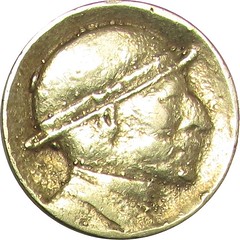
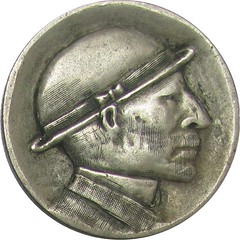
Gold fake, Original Hobo Nickel
For more information about the Original Hobo Nickel Society,
see:
www.hobonickels.org
PROTESTER SCRATCHES 'IN GOD WE TRUST' OFF COINS
I turned on my engraver, and I scratched a bit of metal And repeated this procedure many times Now I’m looking at a little pile of atheistic money— Godless nickels, godless quarters, godless dimes If you want a godless penny, I’ve got some, but not too many And I don’t have any dollar coins so far Now you might well find it funny, scratching “God” off all my money But you know? I like them better as they are.
So I saw the “atheists are hypocrites if they spend money, cos it says ‘In God We Trust’ on it” argument one too many times. And I’ve decided that from now on, whenever I see that argument made, I’m going to de-god another big batch of coins. I already have a marker I use on bills, but paper money only stays in circulation for maybe a couple of years, whereas coins stick around for decades. And yes, I just got done de-godding a big batch this morning, while waiting for a battery to charge so I could do my next task.
I’ve also decided that any and all donations to this site (there’s a donate button down there on the right) will be converted to coins and de-godded. Then comes the fun part–getting them into circulation. Coins tend to stick around in mason jars or cracked mugs until you get fed up and decide to roll them up and bring them to the bank–or worse, to a coin-star machine (why would anyone use those?). Godless money, on the other hand, I am very motivated to get into circulation. So I’ll be an atheist benefactor, topping off parking meters, pre-loading washing machines at the local laundromats (hey, people who use laundromats are generally people who could use some help–I remember those days well), throwing a handful of quarters into the buskers’ guitar cases, loading up the UNICEF boxes at halloween… and, yes, spending them myself–I’m only a part-time altruist; I do need to eat. But now, each quarter (or, if any of you are extremely generous, I’ll have the chance to wear out my engraver on some dollar coins!) spent will have two purposes–helping a particular individual, and spreading godless money.
Does this seem a tad obsessive? Not at all; it is the tiniest fraction of the effort used to put God on all that money in the first place. You want obsessive, try looking at the members of Congress who continue to affirm a motto that is in no danger of ever being recognized as the violation of the first amendment that it is. If this is simply ceremonial deism, then I am doing precisely nothing to these coins.
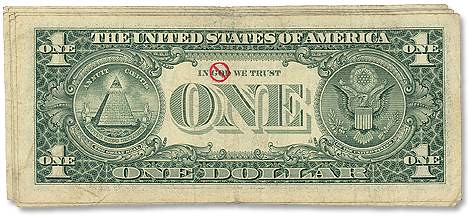
To read the complete articles, see:
Ceremonial De-Deism
(freethoughtblogs.com/cuttlefish/2012/09/27/ceremonial-de-deism/)
Atheists Sue U.S. Government to Take ‘In God We Trust’ Off Our
Money
(www.patheos.com/blogs/friendlyatheist/2013/03/12/atheists-sue-u-s-government-to-take-in-god-we-trust-off-our-money/)
THE BOOK BAZARRE
THE HERITAGE JAMES SMILLIE ARCHIVE SALE
David Gladfelter writes:
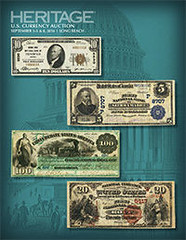 The Heritage currency auction Wednesday night contained material
from the personal archives of James Smillie (1807-1885) and his
son James D. (1833-1909). The prices realized were beyond strong
– they were uniformly double, triple and multiple times high
estimate. The highlights were nine scrapbooks of engravings, the
most expensive of which realized $60K on a $20-25K estimate (lot
18437). Lot 18434, a book of examples of James Smillie’s work in
which I was particularly interested, brought $26K on a $1K-2K
estimate.
The Heritage currency auction Wednesday night contained material
from the personal archives of James Smillie (1807-1885) and his
son James D. (1833-1909). The prices realized were beyond strong
– they were uniformly double, triple and multiple times high
estimate. The highlights were nine scrapbooks of engravings, the
most expensive of which realized $60K on a $20-25K estimate (lot
18437). Lot 18434, a book of examples of James Smillie’s work in
which I was particularly interested, brought $26K on a $1K-2K
estimate.
Also realizing strong prices were vignettes by these and other well-known bank note engravers grouped in lots of ~10-15 by subject matter such as eagles, horses, architectural and military topics.
The Scottish-born James Smillie worked as a bank note engraver for several firms including the National Bank Note Co. and the American Bank Note Co. His son also worked briefly for ABNCo. but was primarily a painter. See Hessler, The Engraver’s Line.
Lot 18441 was a scrapbook kept by Thomas F. Morris that was not part of the archives. It actually sold well below its $4K-6K estimate. I think everyone was shell-shocked and not paying attention (including myself). CAA sold it in 1998 for $4,950 per lot description. I had not targeted this book as a priority (dammit).
Lot 18430: Presentation Book of Large Engraved Scenes From
Around the World ca. 1858

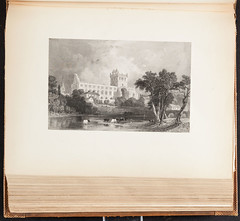
Presentation Book of Large Engraved Scenes From Around the World ca. 1858 from the Smillie Archives
Robert Hinshelwood, an engraver and Smillie family member by marriage, presented this book of approximately 100 large architectural and scenery engravings to James D. Smillie in February, 1858. Many are identified on the back including the subject and artists involved. From The Smillie Family Archives
To view the complete lot description, see:
currency.ha.com/itm/miscellaneous/other/presentation-book
-of-large-engraved-scenes-from-around-the-world-ca-1858
-from-the-smillie-archives/a/3529-18430.s
Lot 18431: James Smillie's Personal 1850 Scrapbook

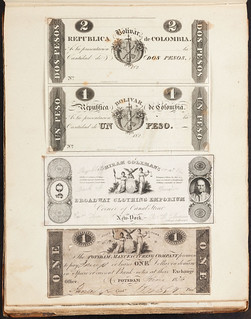
James Smillie's Personal 1850 Scrapbook
Sometimes wonderful things come in humble wrappings. That is
certainly the case with this scrapbook, put together by James
Smillie beginning in 1850. Although the exterior covers and
binding show their age, their condition simply does not matter
once you delve into the contents. Smillie kept business cards,
labels, carte d'visites, bill heads, stock certificates,
bills of exchange, and, yes, even a few bank notes. They all
reside inside this one inch thick volume. There are many hundreds
of neat paper collectibles that, by in large, are in very nice
condition. The glue used to affix them to the pages has not
produced any significant damage. Here are a few of the highlights
of the contents:
- Business Card for S. Stiles & Co. - Engravers & Printers
- 50¢ scrip from the Franklin Street Consistory House Classic School New York
- Labels and Business Cards galore
- Columbia Pick 5 and Pick 6 1 and 2 Peso notes - uncut pair
- Stock certificate on the New York & Mississippi Land Company
- Stock certificate on the Planters Bank of Tennessee
- Stock certificate on the City Bank of Montreal
- Certificate of Deposit on the Ohio Life Insurance & Trust Co. - Cincinnati
- Durand, Perkins & Co. broadside listing prices for engraving and printing bank notes
To view the complete lot description, see:
currency.ha.com/itm/miscellaneous/other/james-smillie
-s-personal-1850-scrapbook/a/3529-18431.s
Lot 18437: Book Entitled "Specimens of Bank Note
Engraving by Toppan, Carpenter, Casilear & Co.
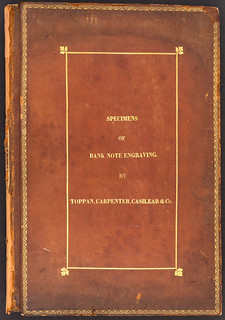
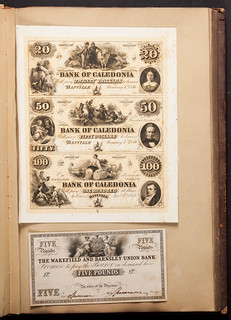
Book Entitled "Specimens of Bank Note Engraving by Toppan, Carpenter, Casilear & Co." From the James Smillie Archive
This book is beautifully bound in light brown leather with the title in gold. The cover is intact but the spine has worn down to the paper backing. The book has over 75 pages and, at one time, it was full of uncut sheets of obsolete proof notes. Ghost images of many can still be detected on a number of the album pages. For whatever reason, most of these sheets were removed and Smillie repurposed parts of the book to mount die proof vignettes and miscellaneous prints that were of interest to him (some fifty pages). Fortunately for collectors, and for reasons which have been lost to time, seven proof sheets remain along with two pages of world proof notes. Sheets remaining are:
- $1,$1,$1,$1 Quinnipiack Bank of New Haven, CT Previously unknown as either a proof or as a sheet. Mounted to card stock with scattered light foxing and minor stains. Four POCs on each note as expected. These are non-issues for a sheet of this extreme rarity.
- $5-$5-$5-$10 Marine Bank of Providence, RI Haxby G8-G8-G8-G10 Durand 1538 x3 - 1542 Previously unknown as a sheet. Mounted to card stock with a small stain affecting only the top $5.
- $1-$1-$2-$5 Marine Bank of Milwaukee, WI Haxby G2-G2-G4-G6 Krause G2-G2-G4-G6 Previously unknown as a proof sheet. Mounted to card stock with minor foxing. 4-5 POCs on each note as expected.
- $20-$50-$100 Bank of Caledonia, Danville, VT Previously unknown as proofs, as a sheet, with this date, and with this imprint. The three subject sheet has a soft peach or orange overall protector tint and light scattered foxing which, again, is a non-issue on a sheet of this extreme rarity
- $1-$1-$1-$1 City Bank of Montreal, Canada Charlton 110-14-02-02P x4 Believed to be the discovery piece in sheet form (a rather unusual 2 x 2 sheet format rather than the customary 4 x 1 layout of this period) Some light scattered foxing.
- $5-$5-$5-$5, Weybosset Bank of Providence, RI Unlisted as a proof in Haxby, Durand 2070 x4 Previously unknown in sheet form. Mounted to card stock with light scattered foxing. Unfortunately someone has removed the lower left vignette of a maiden holding the state seal from the bottom two notes.
- $1-$1-$2-$5 Hudson City Bank of Hudson, WI. Haxby X1 Krause X1 Mounted on card stock with minor foxing noted. Extremely rare with a great provenance.
The world proof notes are from:
- Great Britain - £5 The Kington & Radnorshire Bank ca 1820s Proof on card stock
- Great Britain - £5 The Wakefield and Barnsley Union Bank ca. 1830s-40s Proof on card stock
- Great Britain - £5 The Paisley Commercial Banking Company ca. 1830s-40s Proof on card stock
- Great Britain - £1 The Bolton Bank ca. 1830s-40s Proof on card stock
- Scotland - 100£ The Western Bank of Scotland (Glasgow) ca. 1836
- Isle of Man - £1 Isle of Mann (sic) Commercial Banking Company ca. 1840 In addition, the following items were loose in the book:
- American Bank Note Company advertising note ca. 1870-1880 advertising the company's areas of expertise and Crane & Co.'s Glazed Bond paper. Oval portrait of Washington and light orange overall tint
- Essay for tint elements of an unidentified $20 design printed in blue and gold
- Back proofs for the Banque D'Hochelaga (Canada) for the $5, $10, and $20 1889 series (Charlton 360-14-02P, -04P, -06P) printed in blue. The $5 back is on card stock while the $10 and the $20 are on proof paper.
Obsolete bank note proofs and models:
- South Danvers, MA The Warren Bank $500 G84 Proof The note has had three references to 500 neatly removed. Black and green; mounted on card stock
- Louisville, KY The Bank of Kentucky $5 G20 Hughes 493 Proof 4 POC on card stock
- Philadelphia, PA The Bank of North America $5 G172a as Hoober 305-50 Proof 6 POC
- Portsmouth, NH The Rockingham Bank $1 Proof 6 POC
- Wilmington, DE The Union Bank of Delaware $1 as G2 (but a Proof) Mounted on card stock
- Wilmington, DE The Union Bank of Delaware $2 as G4 (but a Proof) Mounted on card stock
- New Orleans, LA The Citizens Bank of Louisiana $100 as G48a (but a Proof) Mounted on card stock with Bank title and 100 from counter removed. Mounted on card stock 4 POC
- Boston, MA The Bank of Mutual Redemption $5 as G6b except black and white Proof Mounted on card stock. Uniform light foxing on card that does not significantly impact the note itself.
To view the complete lot description, see:
currency.ha.com/itm/miscellaneous/other/book-entitled
-specimens-of-bank-note-engraving-by-toppan-carpenter-casilear
-and-co-from-the-james-smillie-archive/a/3529-18437.s
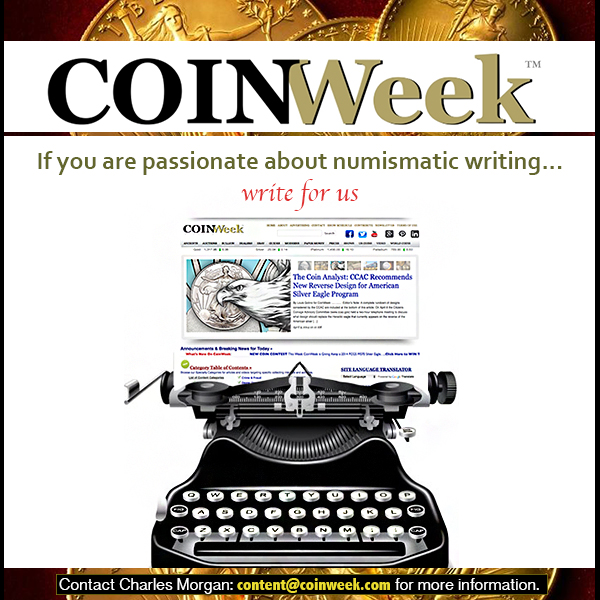
THE ROYAL AFRICAN COMPANY MARK
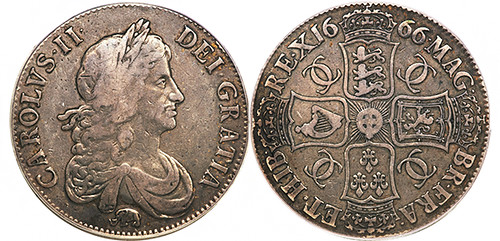
A relatively small number of Charles II silver coins of any denomination survive with the mark of an elephant, which relates to a semi-private company that dominated British business activities in Africa.
Soon after his ascension to the throne in 1660, King Charles II granted a charter to the Company of Royal Adventurers Trading to Africa, which was renamed the Royal African Company (RAC) in 1672. This company was given a monopoly over British trade with a region in western Africa. The RAC lasted until 1752.
From 1688 to 1722, the RAC supplied gold to the Royal Mint and many British coins struck from such gold featured a hallmark of an elephant. In another words, a small portrait of an elephant on a British gold coin, as part of the design, indicated that it was struck with gold that was mined in West Africa and then brought to England by the RAC.
An elephant and a castle was part of the emblem of this company, and many gold coins struck in London by the Royal Mint featured an ‘elephant & castle,’ though a substantial number had just a portrait of an elephant. Each elephant mark, with or without a castle, is found below the bust on the obverse (front of the coin).
 These are regular issue coins
of the Royal Mint of England, not atypical strikings elsewhere.
Such elephant marks are not mintmarks in the sense that the term
‘mintmark’ is employed in the U.S. The Royal African Company did
not produce coins.
These are regular issue coins
of the Royal Mint of England, not atypical strikings elsewhere.
Such elephant marks are not mintmarks in the sense that the term
‘mintmark’ is employed in the U.S. The Royal African Company did
not produce coins.
British gold coins of the era were called Guineas because much of the gold used to strike them came from West Africa. The word Guinea has more than one meaning. Undoubtedly, the British traded in the area that is now known as the Republic of Guinea, a former French colony. Over the centuries, however, the name Guinea generally referred to a particular region of West Africa, not to any one specific kingdom, nation or colony.
The RAC brought gold from the region of Guinea to England and the gold denominations that began in 1663 came to be known as Guineas. Soon, gold coins were issued with denominations of Half-Guinea, One Guinea, Two Guineas and Five Guineas. Much later, One-Third-Guinea coins were minted as well.
Only a miniscule percentage of silver coins of the era had elephant (or ‘elephant & castle’) marks. During the reign of Charles II, some Shillings, Halfcrowns and Crowns, dated 1666 and, later, 1681, had elephant (or ‘elephant & castle’) marks. No other silver coin issues in the 1600s had such marks, as best I can recollect at the moment. There are more than a few gold issues, though, during the reigns of James II, William III & Mary II, and Anne, that have such marks
To read the complete article, see:
Rare 1681 silver Halfcrown of King Charles II, with mark of the
Royal African Company
(www.coinweek.com/featured-news/the-1681-royal-african-company-halfcrown-of-king-charles-ii/)
SOME RECENT COIN DESIGNS: SEPTEMBER 7, 2014
Luxembourg Stainless Steel Coin
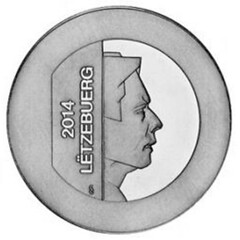
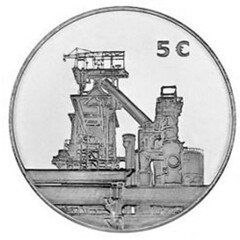
Hungary Coin for Spanyi Bela
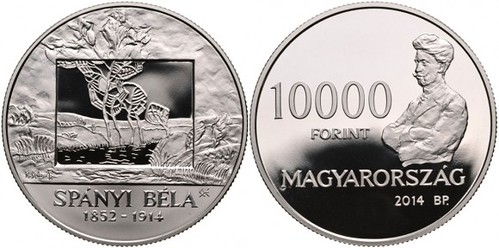
Czech Coin for Krystof Harant
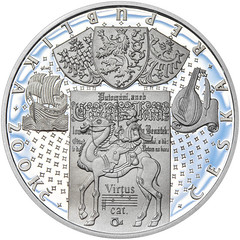

The obverse side of the coin contains a section of the title page of the travel book written by Krystof Harant of Polzice and Bezdruzice “Journey from Bohemia to the Holy Land, by way of Venice and the Sea”, over which Kryštof Harant is pictured sitting on a camel. Below the illustration of Krystof Harant is his motto “Virtus ut sol micat” depicted as a musical score. To the right of the section of the title page is a mandolin, and to the left is a sailing ship on the sea. Above the section of the title page is a composition of heraldic animals from the large national emblem inside shields – the Czech lion is in the middle, with the Moravian eagle on the left and the Silesian eagle on the right.
COIN HONORS BRITISH ARMY'S FIRST BLACK OFFICER
 A special set of coins is to be
released by the Royal Mint to honour the British Army's first
black officer.
A special set of coins is to be
released by the Royal Mint to honour the British Army's first
black officer.
Walter Tull, who was born in Folkestone in 1888, was killed in action leading his men into battle in World War One on the Western front, in 1918.
He was promoted to officer rank during the war, despite a ban on black officers being given the status.
The coin will be part of the commemorations of the centenary of WWI.
Featuring a portrait of the officer with a backdrop of infantry soldiers going "over the top", it will be one of a set of six £5 coins to remember the sacrifices made by many during the war.
To read the complete article, see:
British
Army's first black officer Walter Tull remembered on
coins (www.bbc.com/news/uk-england-kent-29045309)
WWI HORSE HONORED WITH DICKIN MEDAL
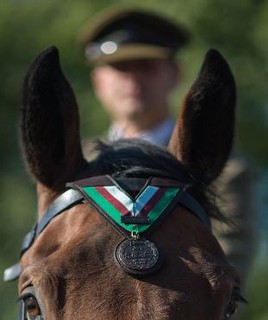 An heroic First World War horse is
to be awarded the "animals' VC" today in
recognition of the gallantry of millions of animals that served
during the conflict.
An heroic First World War horse is
to be awarded the "animals' VC" today in
recognition of the gallantry of millions of animals that served
during the conflict.
The Honorary PDSA Dickin Medal is being presented posthumously to famous war horse Warrior, dubbed "the horse the Germans could not kill" at a special ceremony today.
The award, presented in the centenary year of the First World War, is the first honorary PDSA Dickin Medal ever presented in the veterinary charity's 97-year history as a recognition of the gallantry showed by all the animals that served on the front line during the conflict.
The medal will be accepted by author and broadcaster Brough Scott MBE, grandson of Warrior's owner and rider General Jack Seely, at a special ceremony compered by Kate Adie OBE at the Imperial War Museum (IWM) London this evening, After arriving on the Western Front on August 11 1914 with Gnrl Seely, Warrior stayed there throughout the war, surviving machine gun attacks and falling shells at the Battle of the Somme.
He was dug out of the mud of Passchendaele and twice trapped under the burning beams of his stables, surviving many charges at the enemy and proving an inspiration to the soldiers he was fighting alongside.
Despite suffering several injuries, Warrior survived and returned home to the Isle of Wight in 1918, where he lived with the Seely family until his death aged 33.
The PDSA Dickin Medal, instituted by the charity's founder Maria Dickin in 1943, is recognised as the highest award an animal can achieve while serving in military conflict.
Warrior's award as the first ever First World War recipient of a medal, and the first honorary award, has been recognised by celebrity supporters including Steven Spielberg, director of the Oscar-nominated film War Horse.
To read the complete article, see:
World War horse to get 'animal VC' for gallantry
(www.sthelensstar.co.uk/first_world_war_centenary/
11446756.World_War_horse_to_get__animal_VC__for_gallantry/)

Archives International Auctions, Part XX
Hong Kong 3
Chinese & Asian banknotes, scripophily & coins. Included will be over 270 lots of rare and desirable banknotes.
No earlier than 6PM local time
Highlights include:
- Lot 1847: Netherlands Trading Society $5
- Lot 1942: Hong Kong & Shanghai Banking Association 1913 $1 Specimen Banknote
- Lot 1947: Hong Kong, Mercantile Bank of India 1941 Issue
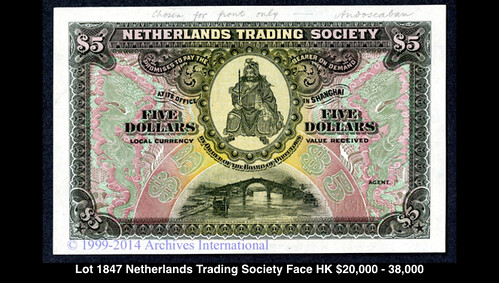
1580 Lemoine Avenue, Suite #7
Fort Lee, NJ 07024
Phone: 201-944-4800
Email: info@archivesinternational.com
WWW.ARCHIVESINTERNATIONAL.COM
OAK TREE THREEPENCE UNEARTHED IN ENGLAND
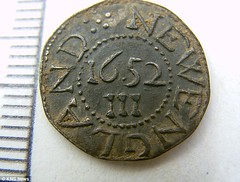

When it was minted 350 years ago, there wouldn’t have been much change from a slap-up meal and a few of pints of ale.
Today the silver threepenny coin that amateur treasure-hunter John Stoner dug up in a farmer’s field would probably buy the entire farm.
The extremely rare New England coin, bearing the date 1652, is expected to sell for up to £1million when it is auctioned.
It has been hailed as one of the finest examples of a currency produced in the days of the Pilgrim Fathers in a land that would become the United States.
How the 17th century threepenny bit ended up in the village of King’s Clipstone, Nottinghamshire, is not known but last night coin collectors from around the world clamoured to buy it.
Mr Stoner, who temporarily mislaid the coin at one point, found it while on an outing with the Coil To The Soil metal detector club on Sunday.
The 42-year-old father of two had only just started to sweep an area of the ploughed field when he picked up two signals from the detector.
The first was from a random piece of metal; the second was from an uneven, hand-hammered coin, about the size of a modern 1p but thinner, buried five inches deep in a clod of earth.
‘I dug up the soil and out it popped,’ he said of the historic find. ‘At first I didn’t think it was anything special. I knew it wasn’t English, but just how important a find it was, I didn’t have a clue.’
On Monday, coin expert Peter Spencer confirmed it was a genuine threepenny piece from the first authorised colonial coinage, commissioned and struck in Boston, Massachusetts.
‘I handed it over to him and I think it’s fair to say he went white as a ghost,’ Mr Stoner said. ‘He said its condition was like the day it was struck.’
Because it is a single coin, it is not subject to treasure trove laws which mean finds have to be reported to a coroner and handed to the Crown. Last night it was on its way to the US for expert cleaning before being offered for sale by St James’s Auctions in London on December 2.
To read the complete article, see:
Minted! Dug up in a Midlands field, a £1m 'perfect' US
threepenny bit from the time of the Pilgrim Fathers
(www.dailymail.co.uk/news/article-2745782/Minted-Dug-Midlands-field-1m-perfect-US-threepenny-bit-time-Pilgrim-Fathers.html)
DAVID PICKUP: UNCOMMON THOUGHTS AND RARITIES
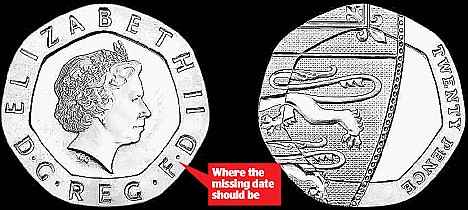
The Royal Mint estimates there less than 250,000 undated 20 pence coins were issued. It is an estimate so the figure may be wrong. If it is correct that means about 1 in 500 of the 136 million 20 pence coins minted in 2008-9 do not have a date. 1 in 500 is rare. The coins retail in the UK for about £45.00 each. The Royal Mint on its website helpfully states that, “These coins remain legal tender and still have a face value of 20p.”
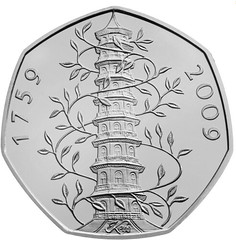 The Kew 50 pence piece sells for about
£25.00 and interestingly if the mintage estimate is correct they
are significantly rarer than the undated 20 pence. About 200,000
of them were minted. The 50 pence piece was described in the
press as “incredibly rare” and prices on the internet went up to
£120.00 at one point. The next two rarest modern coins had
mintages of about 500,000 to 580,000. These two Commonwealth Two
pound coins are hardly ever seen in circulation.
The Kew 50 pence piece sells for about
£25.00 and interestingly if the mintage estimate is correct they
are significantly rarer than the undated 20 pence. About 200,000
of them were minted. The 50 pence piece was described in the
press as “incredibly rare” and prices on the internet went up to
£120.00 at one point. The next two rarest modern coins had
mintages of about 500,000 to 580,000. These two Commonwealth Two
pound coins are hardly ever seen in circulation.
One wonders what would be the better purchase for the collector. The 20 pence is interesting as an example of a glaring error. There are not many errors that are as obvious as this. The Royal Mint’s production and quality standards are extremely good. In the UK there is little collecting interest in errors. Mistrikes, double strikes or even brockages really only a novelty value. However there are less than 250,000 collectors in the world and so everyone who wants an undated 20 pence is likely to have one. The Kew 50 pence piece is a much more attractive and rarer issue.
To read the earlier E-Sylum articles, see:
RAREST
CIRCULATING U.K. COINS
(www.coinbooks.org/esylum_v17n36a26.html)
ROYAL
MINT ERROR: THE DATELESS 2009 TWENTY PENCE
(www.coinbooks.org/esylum_v12n27a09.html)
MORE ON
THE ROYAL MINT'S DATELESS TWENTY PENCE
(www.coinbooks.org/esylum_v13n43a25.html)
THE
CRAZE FOR THE ROYAL MINT'S DATELESS 2009 TWENTY PENCE
(www.coinbooks.org/esylum_v12n28a22.html)
BRITONS
SEARCH FOR RARE KEW GARDENS 50P COIN
(www.coinbooks.org/esylum_v17n08a25.html)
BIN LADEN RAID CHALLENGE COIN
 The shirt a Navy SEAL wore
in the raid that killed Osama bin Laden and a special coin given
to a CIA officer who played a key role in finding him are being
displayed at the Sept. 11 museum, adding potent symbols of the
terrorist attacks' aftermath days before their
anniversary.
The shirt a Navy SEAL wore
in the raid that killed Osama bin Laden and a special coin given
to a CIA officer who played a key role in finding him are being
displayed at the Sept. 11 museum, adding potent symbols of the
terrorist attacks' aftermath days before their
anniversary.
The items are going on view Sunday at the ground zero museum, where leaders see them as an important and moving addition to a collection that often uses personal artifacts to explore the events and impact of 9/11.
"The death of Osama bin Laden is a huge part of the history, and we have an absolute obligation to tell it," National Sept. 11 Memorial Museum President Joe Daniels said Saturday. The display, he said, "allows millions of visitors the chance to recognize the extraordinary bravery of the men and women who sacrifice so much for this country at home and abroad."
The shirt and coin will join an existing display with a brick from the compound in Abbottabad, Pakistan, where the terrorist at the helm of the attacks was captured and killed.
The red, white and blue coin was made to commemorate its conclusion. The coin bears the date — May 1, 2011, in U.S. time — on one side and a red "X'' on the other. It was owned by the CIA officer, known as "Maya," who formed the basis for the main character in the Oscar-winning 2012 movie "Zero Dark Thirty."
The museum is keeping both donors' identities secret.
To read the complete article, see:
9/11 museum shows SEAL's shirt from bin Laden raid
(www.chron.com/news/us/article/9-11-museum-shows-SEAL-s-shirt-from-bin-Laden-raid-5739357.php#photo-6826302)
THE BOOK BAZARRE
ASIA’S HIGHEST DENOMINATED BANKNOTES

A quirky way to examine the development of Asia’s many and varied economies is to take a glance at its banknotes. Quite apart from the staggering array of art and pomp on display, there is also a correlation with the value of their respective economies. I’m not aware of any scientific study that relates high denomination banknotes to the wealth of an economy, but as the chart below suggests, wealthy Asian countries such as Japan (USD97) tend to have higher value denominated banknotes than poorer ones such as Bangladesh (USD12). That is quite a disparity, and reflective of the higher costs of products in Tokyo as opposed to Dhaka.
Although that can be a given, the banknote disparity between the ASEAN nations and China is also of interest. China’s highest value banknote is worth just US$16, and the nation continues to print braille on its currency to allow its high proportion of cataract-affected citizens to read the currency. If ever a symbol of a wealth gap existed, it is found in the fact that against the backdrop of Shanghai’s gleaming billion dollar spires, China’s currency is still marked so that those with eye disorders can actually read it.

Interestingly, India’s highest value note is also worth about the same as China’s, at a little under US$17, while ASEAN’s emerging Asian Tigers provide a mixed set of examples – Malaysia’s highest value note is worth three times more than that of Indonesia, US$31 against just under US$9. Yet Indonesia’s economy is worth far more, at US$878 billion over Malaysia’s US$305 billion. Further, the Indonesian population of 252 million is the fourth largest in the world, and over eight times higher than Malaysia’s 30 million. Based on banknote diversity, wealth it seems is more concentrated amongst a smaller number of Malaysian citizens. While cities such as Kuala Lumpur and Jakarta may be equal in costs and expense, out in the sticks Indonesia remains significantly poorer for large swathes of the population. It would be pointless having large denomination banknotes for a populace who cannot afford to use them, expect those living in the primary cities.

The Philippines and Vietnam are almost at parity in their highest value banknotes, at US$23 and US$24 respectively, while Thailand’s inherent wealth is demonstrated by its denomination of a US$30 equivalent note – nearly double that of China and India. Again, wealth concentration dictates the need for higher value notes, although I am sure there are many in Thailand’s countryside who may disagree.
To read the complete article, see:
The Curious Case of Asia’s Highest Denominated Banknotes
(www.asiabriefing.com/news/2014/09/asias-bank-note-value-diversification/)
BLOGGER REVIEWS MRMOUSE'S COUNTERFEIT CASH
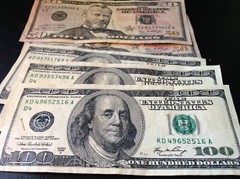 This latest “donation” to Krebs On
Security arrived via USPS Priority Mail, just days after I’d
written about counterfeit cash sold online by a shadowy figure
known only as “MrMouse.” These counterfeits had previously been
offered on “dark web” — sites only accessible using special
software such as Tor — but I wrote about MrMouse’s funny money
because he’d started selling it openly on Reddit, as well as on a
half-dozen hacker forums that are quite reachable on the regular
Internet.
This latest “donation” to Krebs On
Security arrived via USPS Priority Mail, just days after I’d
written about counterfeit cash sold online by a shadowy figure
known only as “MrMouse.” These counterfeits had previously been
offered on “dark web” — sites only accessible using special
software such as Tor — but I wrote about MrMouse’s funny money
because he’d started selling it openly on Reddit, as well as on a
half-dozen hacker forums that are quite reachable on the regular
Internet.
Sure enough, the package contained the minimum order that MrMouse allows: $500, split up into four fake $100s and two phony $50 bills — all with different serial numbers. I have no idea who sent the bogus bills; perhaps it was MrMouse himself, hoping I’d write a review of his offering. After all, since my story about his service was picked up by multiple media outlets, he’s changed his sales thread on several crime forums to read, “As seen on KrebsOnSecurity, Business Insider and Ars Technica…”
Anyhow, it’s not every day that I get a firsthand look at counterfeit cash, so for better for worse, I decided it would be a shame not to write about it.
In the video below, I run the fake bills through two basic tests designed to determine the authenticity of U.S. currency: The counterfeit pen test, and ultraviolet light. As we’ll see in the video, the $50 bills shipped in this package sort of failed the pen test (the fake $100 more or less passed). However, both the $50s and $100s completely flopped on the ultraviolet test. It’s too bad more businesses don’t check bills with a cheapo ultraviolet light: the pen test apparently can be defeated easily (by using acid-free paper or by bleaching real bills and using them as a starting point).
Like most counterfeit currency, these bills look and feel fairly real on casual inspection, but they’d quickly be revealed as fakes to anyone with a $9 ultraviolet pen light or a simple magnifying glass.
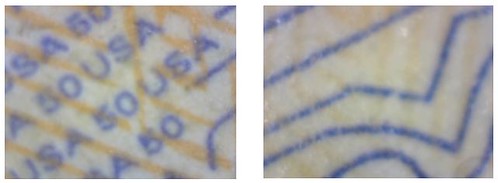
$50 comparison: real, fake
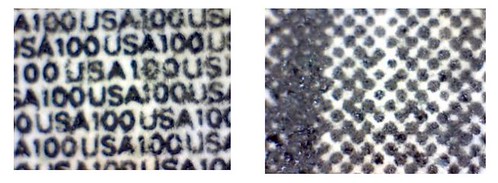
$100 comparison: real, fake
To read the complete article, see:
Fun
With Funny Money
(krebsonsecurity.com/2014/09/fun-with-funny-money/)
MAKING THE U.S. $100 BILL
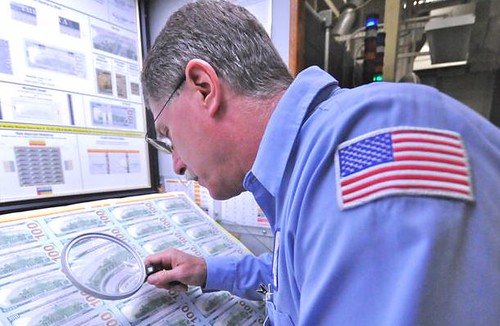
It's hard to know how you're going to feel starting at $320 million in cash.
As part of CNET Road Trip 2014, I got a chance to visit the Western Currency Facility, where the US Bureau of Engraving and Printing produces the majority of America's paper money.
I wanted to see how the latest $100 bills, which have been in circulation since 2013, are made, from the engraving process through printing and packaging. The visit didn't disappoint, especially when I found myself standing in front of five "skids" of $100 bills totaling $320 million. There's a deep sense of longing mixed with an urge to be as nonchalant as you can in the face of such a visceral display of riches.
To read the complete article, see:
All about the Benjamins: Making the $100 bill (pictures)
(www.cnet.com/pictures/all-about-the-benjamins-the-making-of-the-100-bill-pictures/)

ROWLAND CONVICT LOVE TOKEN SOLD
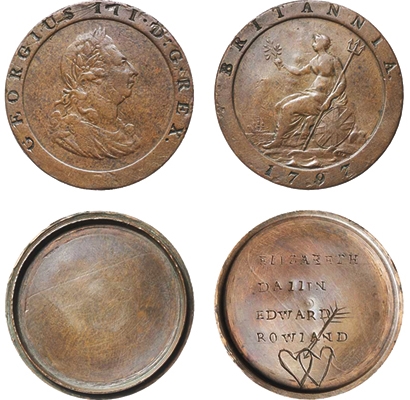
An artifact of a convict’s love nearly tripled its estimate when sold in Noble Numismatics’ July 29 auction.
The 1797 British Cartwheel penny carved into a love token by a convict in Australia sold in the firm’s auction No. 106 in Sydney, for $596.25 Australian (about $560.42 in U.S. funds) including the 19.25 percent buyer’s fee, nearly triple its $200 estimate.
Cartwheel pennies are noted for their size and weight (1 ounce, 36-millimeter diameter), which was possible because they were struck using steam power at Matthew Boulton’s Soho Mint. The Royal Mint lacked the technology to strike a coin of that size.
The piece in the Noble auction is cut in half, hollowed out and made into a container, which is inscribed inside on the base ELIZABETH/DA11IN/EDWARD/ROWLAND, according to the catalog, below which appear overlaid hearts with an arrow through them.
Rowland was sentenced at Central Criminal Court in London to seven years, and was shipped to Australia along with 189 other convicts on the Egyptian. The ship departed April 5, 1839, and arrived in Australia about Dec. 5, 1839.
To read the complete article, see:
Convict’s love token, made from 1797 British Cartwheel penny,
realizes $560 U.S. in auction
(www.coinworld.com/insights/convict_s-love-token--made-from-1797-british-cartwheel-penny--re.html)
MUSÉE D’ART CLASSIQUE DE MOUGINS

Egyptian Gallery
When Christian Levett was a young commodities trader in Paris, he spent his Sundays working off hangovers by walking through the Louvre. “I think I covered every single piece there and believe me, it took some time,” the now 44-year-old, British-born Mr. Levett joked over coffee recently near his vacation home here. “That was really my arts education.”
That was in 1997. Six years later, as his earnings exploded, Mr. Levett, like many hedge fund multimillionaires, plunged into the art market, focusing on hand painted rare books and buying ancient Roman coins.
At that time, the young trader was still oblivious to the market in antiquities. “One day I was ticking off my annual subscription list for catalogs from Sotheby’s, Christie’s and Bonhams,” he remembered. “I had overlooked the antiquities catalogs. I just couldn’t believe that I could buy an ancient helmet, or an eight-foot-high statue or a 2,000-year-old sarcophagus.”
Driven by a new-found passion and backed by a fortune estimated in the hundreds of millions of dollars, Mr. Levett became a voracious buyer, assembling one of the world’s largest private collections of ancient arms and armor. Today, his scores of Greek hoplite helmets, Roman greaves and shields, along with Egyptian sarcophagi, Greek statues and ancient glass, are the crown jewels of his Musée d’art classique de Mougins, housed in a series of medieval buildings in the heart of the small village in the hills above Cannes.
The museum has become a surprising draw in the South of France. It was the only French museum nominated for the 2013 European museum of the year, and it shared the Ken d’Or 2012 award for best museum with the Louvre.

Greco-Roman armor display
Though Mr. Levett did not study art in college, he did have some interest in the field as a youngster, growing up in Essex, England, the son of a bookmaker and a mother with a strong interest in history.
“There happened to be a shop that sold coins at the end of our street,” said Mr. Levett, dressed in blue jeans and a sport shirt. “I was always fascinated by the history of the First and Second World Wars so as a kid I built a collection of very cheap coins and World War campaign medals.”
To read the complete article, see:
Investments in Antiquities Pay Off in Museum in the South of
France
(www.nytimes.com/2014/09/03/arts/international/investments-in-antiquities-pay-off-in-new-museum-in-the-south-of-france.html?ref=arts&_r=0)
THE AMAZING NEW IKEA BOOK-BOOK
Tom Fort writes:
Regarding my posting the other day about e-books, our friends at IKEA amply demonstrate the advantages of a book book over an e-book
To play on the fact that browsing an IKEA catalog is a sort of holistic sensory experience, the company has created this clever new ad, which skewers Apple’s notoriously over-the-top product commercials. The result is hilarious, and the jokes really just write themselves.
“The 2015 IKEA catalog comes fully charged, and the battery is eternal,” says an exec named Jörgen Eghammer, also known as Chief Design Güru. He explains that this catalog is not a digital book or an e-book, but a bookbook. “The navigation is based on tactile touch technology that you can actually feel,” he adds.
We’ve seen plenty of good Apple commercial parodies before, but IKEA definitely gets major points for this promo.
To read the complete article, see:
IKEA
Channels Apple in a Hilarious Ad for Its New Catalog
‘Bookbook’ (time.com/3265308/ikea-catalog-2015/)
To read the earlier E-Sylum article, see:
WHO GETS
YOUR E-BOOKS WHEN YOU DIE?
(www.coinbooks.org/esylum_v17n35a20.html)
FEATURED WEB SITE: INSTITUTE FOR CONSERVATION
This week's Featured Web Site is the American Institute for Conservation of Historic and Artistic Works, suggested by Dave Lange.As the only national membership organization in the United States dedicated to the preservation of cultural material, the American Institute for Conservation of Historic and Artistic Works plays a crucial role in establishing and upholding professional standards, promoting research and publications, providing educational opportunities, and fostering the exchange of knowledge among conservators, allied professionals, and the public.
From humble beginnings and a handful of members in 1972, AIC has grown to over 3,500 conservators, educators, scientists, students, archivists, art historians, and other conservation enthusiasts in over twenty countries around the world, all of whom have the same goal: to preserve the material evidence of our past so we can learn from it today and appreciate it in the future.
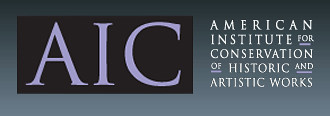
www.conservation-us.org

